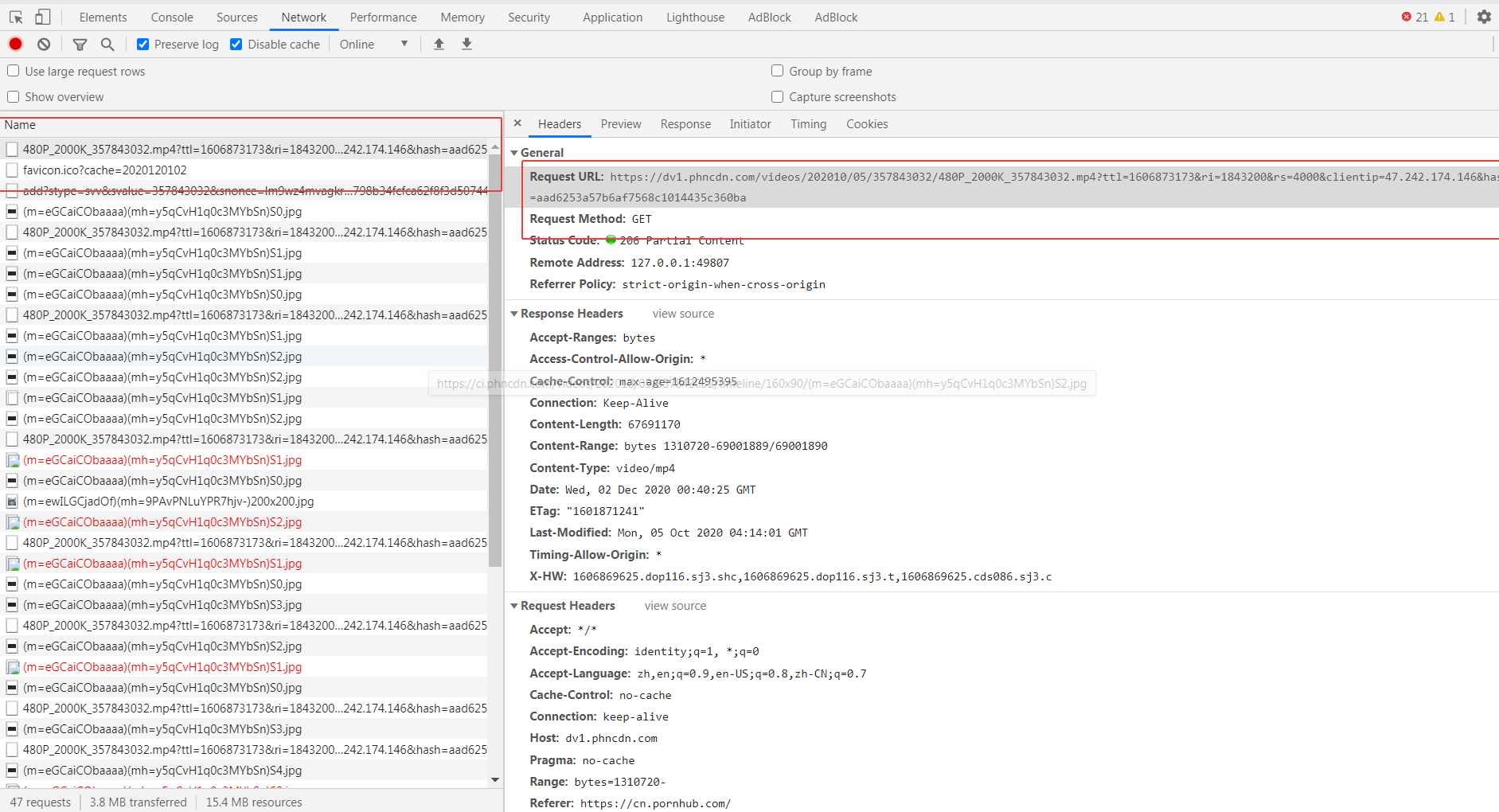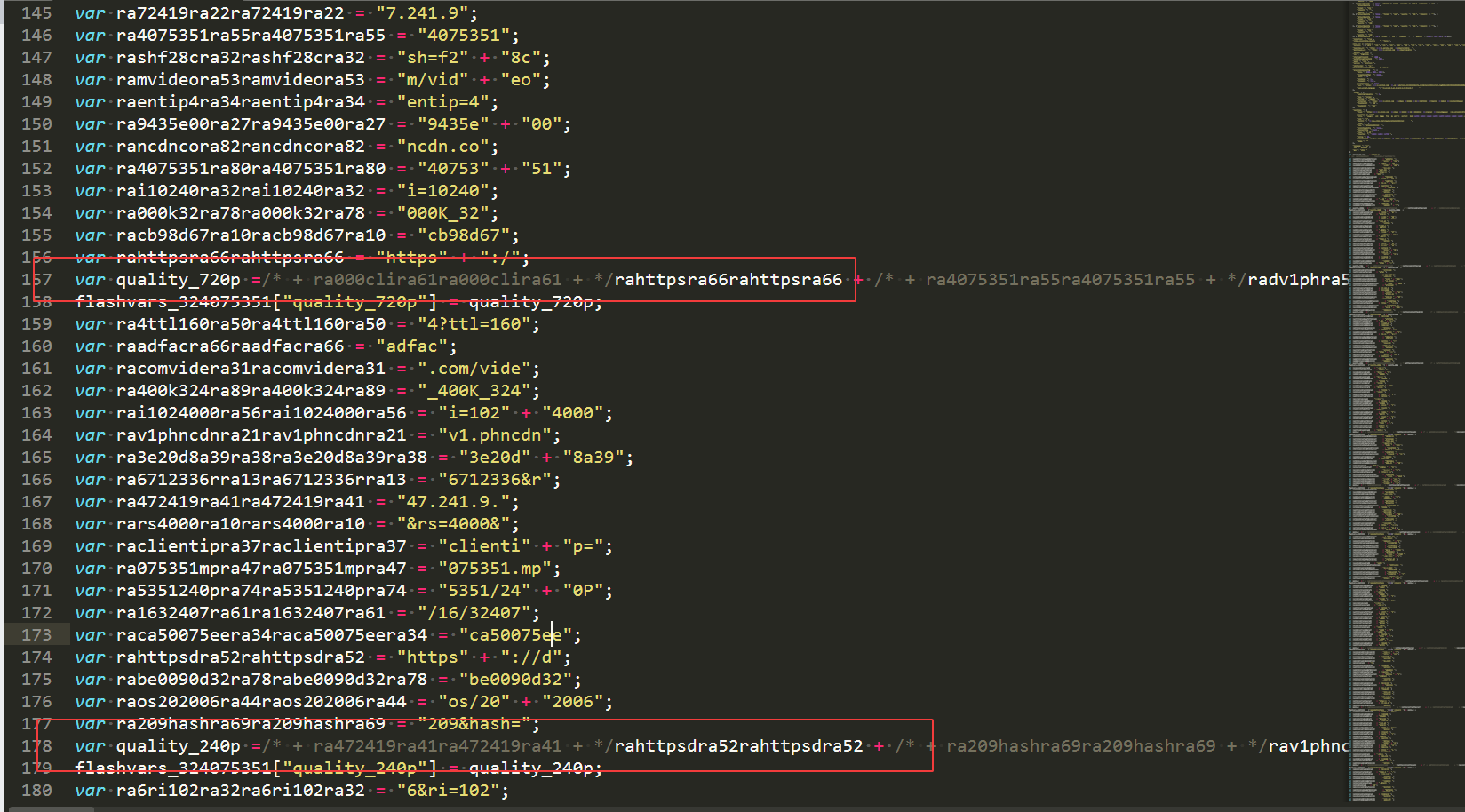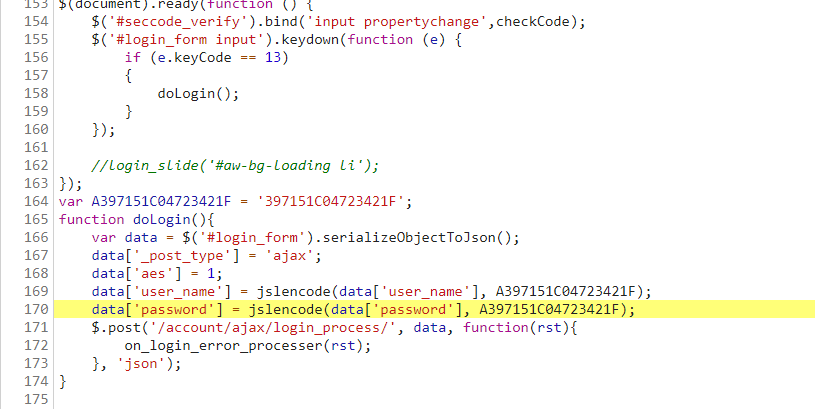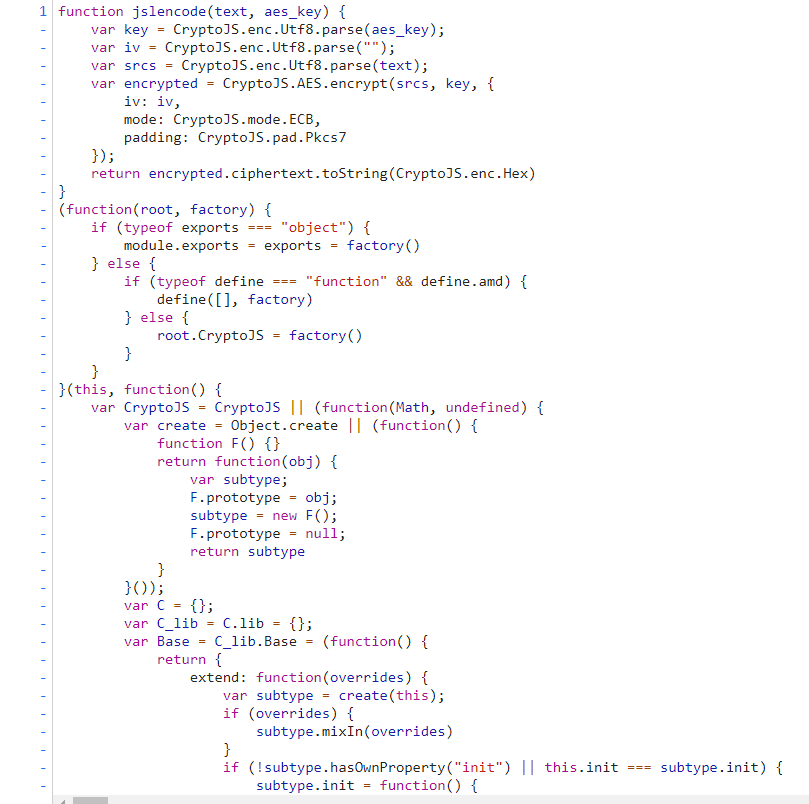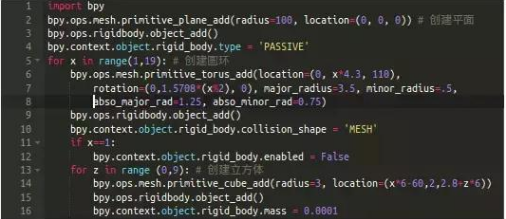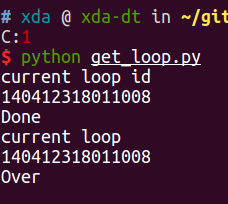通知设置 新通知
P站 视频下载 JS加密URL 【JS逆向】
python爬虫 • 李魔佛 发表了文章 • 0 个评论 • 31640 次浏览 • 2020-12-02 10:43
它的真实下载地址是隐藏在JS加密当中的。
接下来我们看看如何找到它的真实地址。
首先随便打开一个视频:
我就找一个python学习的视频(什么鬼,上面还有python学习? 是的有的,还有很多数学题目在上面讲解的呢)
然后按F12
找到一个疑似的下载地址
试下拷贝直接去打开,发现无法打开,显示403 fobiden。
但是看url,应该就是最终的下载url的格式,通过最后的随机数控制播放权限。
然后打开页面的源码
在里面找下有没有一些mp4等的字符, 然后发现有个720p,1080p不同分辨率格式的字段,我们把这个JavaScript的代码扣下来,然后保存为p_hub.js
用vs code 或者其他编辑器打开
看到了他们生成过程了吗?
然后尝试用nodejs运行一下。
什么都没有输出。
因为上面代码并没有任何输出语句,我们在最后加一个 console.log(quality_720p); 就会有输出的了。
看到了吗?
然后拿这个地址去试试,看能否播放和下载。
果然,浏览器里面出现了一个, 额, python学习的页面,一个单独的视频页面,所以可以直接右键,弹出一个保存视频的菜单,然后可以直接下载了。
用代码requesets.get(url) 保存text.content 写入文件,就可以把视频保存到本地了。
源码:#!/usr/bin/env python
# http://30daydo.com
import os
import re
import js2py
import requests
from lxml import etree
from clint.textui import progress
import fire
from loguru import logger
file='crawler'
logger.add(
"logs/%s.log" % file,
format="{time:MM-DD HH:mm:ss} {level} {message}",
)
headers = {
"User-Agent": "Mozilla/5.0 (Macintosh; Intel Mac OS X 10_13_1) AppleWebKit/537.36 (KHTML, like Gecko) Chrome/63.0.3239.84 Safari/537.36",
}
proxies = {}
# 如果代理不稳定,不推荐使用
# local proxy service
# proxies example:
# proxies = {
# "http": "socks5://127.0.0.1:1080",
# "https": "socks5://127.0.0.1:1080",
# }
def list_page(url):
logger.info("crawling : %s" % url)
resp = requests.get(url, headers=headers, proxies=proxies, verify=False)
html = etree.HTML(resp.text)
buff = '//*[@class="phimage"]/a/'
names = html.xpath(f"{buff}@href")
urls = html.xpath(f"{buff}img/@data-mediabook")
for i in range(len(urls)):
try:
url = urls
[i] name = re.findall("=ph(\w+)", names[i])[-1]
logger.info(f"{url} {name}")
download(url, name, "webm")
except Exception as err:
logger.error(err)
def detail_page(url):
s = requests.Session()
resp = s.get(url, headers=headers, proxies=proxies, verify=False)
html = etree.HTML(resp.content)
title = "".join(html.xpath("//h1//text()")).strip()
logger.info(title)
js_temp = html.xpath("//script/text()")
for j in js_temp:
if "flashvars" in j:
videoUrl = exeJs(j)
download(videoUrl, title, "mp4")
continue
def exeJs(js):
flashvars = re.findall("flashvars_\d+", js)[0]
js = "\n\t".join(js.split("\n\t")[:-5]).strip()
js = js.replace("// var nextVideoObject = flashvars_['nextVideo'];",'')
js+=flashvars
res = js2py.eval_js(js)
if res.quality_720p:
return res.quality_720p
elif res.quality_480p:
return res.quality_480p
elif res.quality_240p:
return res.quality_240p
else:
logger.error("parse url error")
def download(url, name, filetype):
logger.info(f"{url} {name} {filetype}")
filepath = "%s/%s.%s" % (filetype, name, filetype)
if os.path.exists(filepath):
logger.info("this file had been downloaded :: %s" % filepath)
return
else:
response = requests.get(url, headers=headers, proxies=proxies, stream=True)
with open(filepath, "wb") as file:
total_length = int(response.headers.get("content-length"))
for ch in progress.bar(
response.iter_content(chunk_size=2391975),
expected_size=(total_length / 1024) + 1,
):
if ch:
file.write(ch)
logger.info("download success :: %s" % filepath)
def run(_arg=None):
paths = ["webm", "mp4"]
for path in paths:
if not os.path.exists(path):
os.mkdir(path)
if _arg == "webm":
# https://www.pornhub.com/categories
urls = [
# "https://www.pornhub.com/video?o=tr",
# "https://www.pornhub.com/video?o=ht",
# "https://www.pornhub.com/video?o=mv",
"https://www.pornhub.com/video",
]
for url in urls:
list_page(url)
elif _arg == "mp4":
with open("download.txt", "r") as file:
keys = list(set(file.readlines()))
logger.info(keys)
keys += [d.strip(".webm") for d in os.listdir("webm/")]
for key in keys:
if not key.strip():
continue
url = "https://www.pornhub.com/view_v ... ot%3B % key.strip()
logger.info("url: {}", url)
detail_page(url)
else:
_str = """
tips:
python crawler.py webm
- 下载热门页面的缩略图,路径为webm文件夹下
python crawler.py mp4
- 该命令会下载webm文件下对应的mp4文件
- 也可以将目标地址写入download.txt中
"""
logger.info(_str)
return
logger.info("finish !")
if __name__ == "__main__":
fire.Fire(run)
[/i][/i]
[i]原创文章,
转载请注明出处:
http://30daydo.com/article/44115
[/i]
[i]
[/i] 查看全部
它的真实下载地址是隐藏在JS加密当中的。
接下来我们看看如何找到它的真实地址。
首先随便打开一个视频:
我就找一个python学习的视频(什么鬼,上面还有python学习? 是的有的,还有很多数学题目在上面讲解的呢)
然后按F12
找到一个疑似的下载地址
试下拷贝直接去打开,发现无法打开,显示403 fobiden。
但是看url,应该就是最终的下载url的格式,通过最后的随机数控制播放权限。
然后打开页面的源码
在里面找下有没有一些mp4等的字符, 然后发现有个720p,1080p不同分辨率格式的字段,我们把这个JavaScript的代码扣下来,然后保存为p_hub.js
用vs code 或者其他编辑器打开
看到了他们生成过程了吗?
然后尝试用nodejs运行一下。
什么都没有输出。
因为上面代码并没有任何输出语句,我们在最后加一个 console.log(quality_720p); 就会有输出的了。
看到了吗?
然后拿这个地址去试试,看能否播放和下载。
果然,浏览器里面出现了一个, 额, python学习的页面,一个单独的视频页面,所以可以直接右键,弹出一个保存视频的菜单,然后可以直接下载了。
用代码requesets.get(url) 保存text.content 写入文件,就可以把视频保存到本地了。
源码:
#!/usr/bin/env python
# http://30daydo.com
import os
import re
import js2py
import requests
from lxml import etree
from clint.textui import progress
import fire
from loguru import logger
file='crawler'
logger.add(
"logs/%s.log" % file,
format="{time:MM-DD HH:mm:ss} {level} {message}",
)
headers = {
"User-Agent": "Mozilla/5.0 (Macintosh; Intel Mac OS X 10_13_1) AppleWebKit/537.36 (KHTML, like Gecko) Chrome/63.0.3239.84 Safari/537.36",
}
proxies = {}
# 如果代理不稳定,不推荐使用
# local proxy service
# proxies example:
# proxies = {
# "http": "socks5://127.0.0.1:1080",
# "https": "socks5://127.0.0.1:1080",
# }
def list_page(url):
logger.info("crawling : %s" % url)
resp = requests.get(url, headers=headers, proxies=proxies, verify=False)
html = etree.HTML(resp.text)
buff = '//*[@class="phimage"]/a/'
names = html.xpath(f"{buff}@href")
urls = html.xpath(f"{buff}img/@data-mediabook")
for i in range(len(urls)):
try:
url = urls
[i] name = re.findall("=ph(\w+)", names[i])[-1]
logger.info(f"{url} {name}")
download(url, name, "webm")
except Exception as err:
logger.error(err)
def detail_page(url):
s = requests.Session()
resp = s.get(url, headers=headers, proxies=proxies, verify=False)
html = etree.HTML(resp.content)
title = "".join(html.xpath("//h1//text()")).strip()
logger.info(title)
js_temp = html.xpath("//script/text()")
for j in js_temp:
if "flashvars" in j:
videoUrl = exeJs(j)
download(videoUrl, title, "mp4")
continue
def exeJs(js):
flashvars = re.findall("flashvars_\d+", js)[0]
js = "\n\t".join(js.split("\n\t")[:-5]).strip()
js = js.replace("// var nextVideoObject = flashvars_['nextVideo'];",'')
js+=flashvars
res = js2py.eval_js(js)
if res.quality_720p:
return res.quality_720p
elif res.quality_480p:
return res.quality_480p
elif res.quality_240p:
return res.quality_240p
else:
logger.error("parse url error")
def download(url, name, filetype):
logger.info(f"{url} {name} {filetype}")
filepath = "%s/%s.%s" % (filetype, name, filetype)
if os.path.exists(filepath):
logger.info("this file had been downloaded :: %s" % filepath)
return
else:
response = requests.get(url, headers=headers, proxies=proxies, stream=True)
with open(filepath, "wb") as file:
total_length = int(response.headers.get("content-length"))
for ch in progress.bar(
response.iter_content(chunk_size=2391975),
expected_size=(total_length / 1024) + 1,
):
if ch:
file.write(ch)
logger.info("download success :: %s" % filepath)
def run(_arg=None):
paths = ["webm", "mp4"]
for path in paths:
if not os.path.exists(path):
os.mkdir(path)
if _arg == "webm":
# https://www.pornhub.com/categories
urls = [
# "https://www.pornhub.com/video?o=tr",
# "https://www.pornhub.com/video?o=ht",
# "https://www.pornhub.com/video?o=mv",
"https://www.pornhub.com/video",
]
for url in urls:
list_page(url)
elif _arg == "mp4":
with open("download.txt", "r") as file:
keys = list(set(file.readlines()))
logger.info(keys)
keys += [d.strip(".webm") for d in os.listdir("webm/")]
for key in keys:
if not key.strip():
continue
url = "https://www.pornhub.com/view_v ... ot%3B % key.strip()
logger.info("url: {}", url)
detail_page(url)
else:
_str = """
tips:
python crawler.py webm
- 下载热门页面的缩略图,路径为webm文件夹下
python crawler.py mp4
- 该命令会下载webm文件下对应的mp4文件
- 也可以将目标地址写入download.txt中
"""
logger.info(_str)
return
logger.info("finish !")
if __name__ == "__main__":
fire.Fire(run)
[/i][/i]
[i]原创文章,
转载请注明出处:
http://30daydo.com/article/44115
[/i]
[i] [/i]
pycharm 条件断点
李魔佛 发表了文章 • 0 个评论 • 3028 次浏览 • 2020-12-01 13:42
先在想要停下来的地方打一个断点,然后再点击一下断点,弹出的一个条件断点的窗口,在窗口输入一个条件即可。
比如:
def main():
for i in range(100):
print(i*i)
if __name__ == '__main__':
main()
在i*i的地方打一个断点,然后在条件断点那里输入 i=50, 那么在调试模式下只有在i=50的时候才会停下来。
查看全部
先在想要停下来的地方打一个断点,然后再点击一下断点,弹出的一个条件断点的窗口,在窗口输入一个条件即可。
比如:
def main():
for i in range(100):
print(i*i)
if __name__ == '__main__':
main()
在i*i的地方打一个断点,然后在条件断点那里输入 i=50, 那么在调试模式下只有在i=50的时候才会停下来。
python执行js语句,无函数返回值
李魔佛 发表了文章 • 0 个评论 • 3095 次浏览 • 2020-11-30 16:11
如下面的一段JSvar radra27radra27 = "D";
var ra72419ra91ra72419ra91 = "7.241.9" + ".";
var raurst500ra63raurst500ra63 = "urst=500";
var ravalidtora49ravalidtora49 = "validto=";
var raevphncdra57raevphncdra57 = "ev.ph" + "ncd";
var ra16067161ra17ra16067161ra17 = "16067161";
var radeos202ra16radeos202ra16 = "deos/20" + "2";
var ra1080p4ra73ra1080p4ra73 = "/1080P_4";
var ra209hashra72ra209hashra72 = "209&hash";
var ra2bmkdz7nra36ra2bmkdz7nra36 = "2BMKd" + "z7N";
var ra6708909ra29ra6708909ra29 = "6708909" + "&";
var ra00kip4ra41ra00kip4ra41 = "00k&i" + "p=4";
var ra006163ra73ra006163ra73 = "006/16/" + "3";
var raro7upu3ra66raro7upu3ra66 = "Ro7UPU%3";
var raroiu6qra26raroiu6qra26 = "=rOiU6q%";
var ra075351mra26ra075351mra26 = "075351." + "m";
var ramgdmctbvra11ramgdmctbvra11 = "MgdmCtbV";
var rap4validra25rap4validra25 = "p4?valid";
var ra09ratera79ra09ratera79 = "09&rate=";
var rancomvira35rancomvira35 = "n.com/vi";
var ra24075351ra94ra24075351ra94 = "24075" + "351";
var ra000k324ra70ra000k324ra70 = "000K_324";
var ra50000kbra49ra50000kbra49 = "50000k&" + "b";
var rahttpsra83rahttpsra83 = "https://";
var rafrom160ra56rafrom160ra56 = "from=16" + "0";
var quality_1080p =/* + radra27radra27 + */rahttpsra83rahttpsra83 + /* + rancomvira35rancomvira35 + */raevphncdra57raevphncdra57 + /* + radra27radra27 + */rancomvira35rancomvira35 + /* + ra006163ra73ra006163ra73 + */radeos202ra16radeos202ra16 + /* + ra09ratera79ra09ratera79 + */ra006163ra73ra006163ra73 + /* + ra1080p4ra73ra1080p4ra73 + */ra24075351ra94ra24075351ra94 + /* + raroiu6qra26raroiu6qra26 + */ra1080p4ra73ra1080p4ra73 + /* + ra000k324ra70ra000k324ra70 + */ra000k324ra70ra000k324ra70 + /* + rancomvira35rancomvira35 + */ra075351mra26ra075351mra26 + /* + ravalidtora49ravalidtora49 + */rap4validra25rap4validra25 + /* + ra209hashra72ra209hashra72 + */rafrom160ra56rafrom160ra56 + /* + ra1080p4ra73ra1080p4ra73 + */ra6708909ra29ra6708909ra29 + /* + ra209hashra72ra209hashra72 + */ravalidtora49ravalidtora49 + /* + ramgdmctbvra11ramgdmctbvra11 + */ra16067161ra17ra16067161ra17 + /* + ra24075351ra94ra24075351ra94 + */ra09ratera79ra09ratera79 + /* + ra50000kbra49ra50000kbra49 + */ra50000kbra49ra50000kbra49 + /* + ramgdmctbvra11ramgdmctbvra11 + */raurst500ra63raurst500ra63 + /* + ra209hashra72ra209hashra72 + */ra00kip4ra41ra00kip4ra41 + /* + raroiu6qra26raroiu6qra26 + */ra72419ra91ra72419ra91 + /* + ra09ratera79ra09ratera79 + */ra209hashra72ra209hashra72 + /* + raro7upu3ra66raro7upu3ra66 + */raroiu6qra26raroiu6qra26 + /* + ra075351mra26ra075351mra26 + */ra2bmkdz7nra36ra2bmkdz7nra36 + /* + ra50000kbra49ra50000kbra49 + */ramgdmctbvra11ramgdmctbvra11 + /* + radeos202ra16radeos202ra16 + */raro7upu3ra66raro7upu3ra66 + /* + ra075351mra26ra075351mra26 + */radra27radra27;
flashvars_324075351["quality_1080p"] = quality_1080p;
做了很多的运算,掩人耳目,虽然看多几下,用python写也简单,或者把它放入一个function里面也可以。
比如实时网络上下载获取一段js,然后再在头部和尾部组装为function。
function getValue(){
xxxxxx
xxxxxx
return flashvars_324075351
}
然后执行这一段JS,call返回函数 getValue() 就可以拿到返回值了。
不过今天我们用其他的方法直接获取flashvars_324075351
使用jsp库即可。
把上面的JS语句var radra27radra27 = "D";
var ra72419ra91ra72419ra91 = "7.241.9" + ".";
var raurst500ra63raurst500ra63 = "urst=500";
var ravalidtora49ravalidtora49 = "validto=";
var raevphncdra57raevphncdra57 = "ev.ph" + "ncd";
var ra16067161ra17ra16067161ra17 = "16067161";
var radeos202ra16radeos202ra16 = "deos/20" + "2";
var ra1080p4ra73ra1080p4ra73 = "/1080P_4";
var ra209hashra72ra209hashra72 = "209&hash";
var ra2bmkdz7nra36ra2bmkdz7nra36 = "2BMKd" + "z7N";
var ra6708909ra29ra6708909ra29 = "6708909" + "&";
var ra00kip4ra41ra00kip4ra41 = "00k&i" + "p=4";
var ra006163ra73ra006163ra73 = "006/16/" + "3";
var raro7upu3ra66raro7upu3ra66 = "Ro7UPU%3";
var raroiu6qra26raroiu6qra26 = "=rOiU6q%";
var ra075351mra26ra075351mra26 = "075351." + "m";
var ramgdmctbvra11ramgdmctbvra11 = "MgdmCtbV";
var rap4validra25rap4validra25 = "p4?valid";
var ra09ratera79ra09ratera79 = "09&rate=";
var rancomvira35rancomvira35 = "n.com/vi";
var ra24075351ra94ra24075351ra94 = "24075" + "351";
var ra000k324ra70ra000k324ra70 = "000K_324";
var ra50000kbra49ra50000kbra49 = "50000k&" + "b";
var rahttpsra83rahttpsra83 = "https://";
var rafrom160ra56rafrom160ra56 = "from=16" + "0";
var quality_1080p =/* + radra27radra27 + */rahttpsra83rahttpsra83 + /* + rancomvira35rancomvira35 + */raevphncdra57raevphncdra57 + /* + radra27radra27 + */rancomvira35rancomvira35 + /* + ra006163ra73ra006163ra73 + */radeos202ra16radeos202ra16 + /* + ra09ratera79ra09ratera79 + */ra006163ra73ra006163ra73 + /* + ra1080p4ra73ra1080p4ra73 + */ra24075351ra94ra24075351ra94 + /* + raroiu6qra26raroiu6qra26 + */ra1080p4ra73ra1080p4ra73 + /* + ra000k324ra70ra000k324ra70 + */ra000k324ra70ra000k324ra70 + /* + rancomvira35rancomvira35 + */ra075351mra26ra075351mra26 + /* + ravalidtora49ravalidtora49 + */rap4validra25rap4validra25 + /* + ra209hashra72ra209hashra72 + */rafrom160ra56rafrom160ra56 + /* + ra1080p4ra73ra1080p4ra73 + */ra6708909ra29ra6708909ra29 + /* + ra209hashra72ra209hashra72 + */ravalidtora49ravalidtora49 + /* + ramgdmctbvra11ramgdmctbvra11 + */ra16067161ra17ra16067161ra17 + /* + ra24075351ra94ra24075351ra94 + */ra09ratera79ra09ratera79 + /* + ra50000kbra49ra50000kbra49 + */ra50000kbra49ra50000kbra49 + /* + ramgdmctbvra11ramgdmctbvra11 + */raurst500ra63raurst500ra63 + /* + ra209hashra72ra209hashra72 + */ra00kip4ra41ra00kip4ra41 + /* + raroiu6qra26raroiu6qra26 + */ra72419ra91ra72419ra91 + /* + ra09ratera79ra09ratera79 + */ra209hashra72ra209hashra72 + /* + raro7upu3ra66raro7upu3ra66 + */raroiu6qra26raroiu6qra26 + /* + ra075351mra26ra075351mra26 + */ra2bmkdz7nra36ra2bmkdz7nra36 + /* + ra50000kbra49ra50000kbra49 + */ramgdmctbvra11ramgdmctbvra11 + /* + radeos202ra16radeos202ra16 + */raro7upu3ra66raro7upu3ra66 + /* + ra075351mra26ra075351mra26 + */radra27radra27;
flashvars_324075351["quality_1080p"] = quality_1080p;
后面加一个返回值,但不需要加return
比如....
ra50000kbra49ra50000kbra49 + */ramgdmctbvra11ramgdmctbvra11 + /* + radeos202ra16radeos202ra16 + */raro7upu3ra66raro7upu3ra66 + /* + ra075351mra26ra075351mra26 + */radra27radra27;
flashvars_324075351["quality_1080p"] = quality_1080p;
flashvars_324075351;
然后直接调用jspy
res = js2py.eval_js(js)
执行后print(res) , 显示的值就是flashvars_324075351
原创文章,转载请注明出处
http://30daydo.com/article/44112
查看全部
如下面的一段JS
var radra27radra27 = "D";
var ra72419ra91ra72419ra91 = "7.241.9" + ".";
var raurst500ra63raurst500ra63 = "urst=500";
var ravalidtora49ravalidtora49 = "validto=";
var raevphncdra57raevphncdra57 = "ev.ph" + "ncd";
var ra16067161ra17ra16067161ra17 = "16067161";
var radeos202ra16radeos202ra16 = "deos/20" + "2";
var ra1080p4ra73ra1080p4ra73 = "/1080P_4";
var ra209hashra72ra209hashra72 = "209&hash";
var ra2bmkdz7nra36ra2bmkdz7nra36 = "2BMKd" + "z7N";
var ra6708909ra29ra6708909ra29 = "6708909" + "&";
var ra00kip4ra41ra00kip4ra41 = "00k&i" + "p=4";
var ra006163ra73ra006163ra73 = "006/16/" + "3";
var raro7upu3ra66raro7upu3ra66 = "Ro7UPU%3";
var raroiu6qra26raroiu6qra26 = "=rOiU6q%";
var ra075351mra26ra075351mra26 = "075351." + "m";
var ramgdmctbvra11ramgdmctbvra11 = "MgdmCtbV";
var rap4validra25rap4validra25 = "p4?valid";
var ra09ratera79ra09ratera79 = "09&rate=";
var rancomvira35rancomvira35 = "n.com/vi";
var ra24075351ra94ra24075351ra94 = "24075" + "351";
var ra000k324ra70ra000k324ra70 = "000K_324";
var ra50000kbra49ra50000kbra49 = "50000k&" + "b";
var rahttpsra83rahttpsra83 = "https://";
var rafrom160ra56rafrom160ra56 = "from=16" + "0";
var quality_1080p =/* + radra27radra27 + */rahttpsra83rahttpsra83 + /* + rancomvira35rancomvira35 + */raevphncdra57raevphncdra57 + /* + radra27radra27 + */rancomvira35rancomvira35 + /* + ra006163ra73ra006163ra73 + */radeos202ra16radeos202ra16 + /* + ra09ratera79ra09ratera79 + */ra006163ra73ra006163ra73 + /* + ra1080p4ra73ra1080p4ra73 + */ra24075351ra94ra24075351ra94 + /* + raroiu6qra26raroiu6qra26 + */ra1080p4ra73ra1080p4ra73 + /* + ra000k324ra70ra000k324ra70 + */ra000k324ra70ra000k324ra70 + /* + rancomvira35rancomvira35 + */ra075351mra26ra075351mra26 + /* + ravalidtora49ravalidtora49 + */rap4validra25rap4validra25 + /* + ra209hashra72ra209hashra72 + */rafrom160ra56rafrom160ra56 + /* + ra1080p4ra73ra1080p4ra73 + */ra6708909ra29ra6708909ra29 + /* + ra209hashra72ra209hashra72 + */ravalidtora49ravalidtora49 + /* + ramgdmctbvra11ramgdmctbvra11 + */ra16067161ra17ra16067161ra17 + /* + ra24075351ra94ra24075351ra94 + */ra09ratera79ra09ratera79 + /* + ra50000kbra49ra50000kbra49 + */ra50000kbra49ra50000kbra49 + /* + ramgdmctbvra11ramgdmctbvra11 + */raurst500ra63raurst500ra63 + /* + ra209hashra72ra209hashra72 + */ra00kip4ra41ra00kip4ra41 + /* + raroiu6qra26raroiu6qra26 + */ra72419ra91ra72419ra91 + /* + ra09ratera79ra09ratera79 + */ra209hashra72ra209hashra72 + /* + raro7upu3ra66raro7upu3ra66 + */raroiu6qra26raroiu6qra26 + /* + ra075351mra26ra075351mra26 + */ra2bmkdz7nra36ra2bmkdz7nra36 + /* + ra50000kbra49ra50000kbra49 + */ramgdmctbvra11ramgdmctbvra11 + /* + radeos202ra16radeos202ra16 + */raro7upu3ra66raro7upu3ra66 + /* + ra075351mra26ra075351mra26 + */radra27radra27;
flashvars_324075351["quality_1080p"] = quality_1080p;
做了很多的运算,掩人耳目,虽然看多几下,用python写也简单,或者把它放入一个function里面也可以。
比如实时网络上下载获取一段js,然后再在头部和尾部组装为function。
function getValue(){
xxxxxx
xxxxxx
return flashvars_324075351
}
然后执行这一段JS,call返回函数 getValue() 就可以拿到返回值了。
不过今天我们用其他的方法直接获取flashvars_324075351
使用jsp库即可。
把上面的JS语句
var radra27radra27 = "D";
var ra72419ra91ra72419ra91 = "7.241.9" + ".";
var raurst500ra63raurst500ra63 = "urst=500";
var ravalidtora49ravalidtora49 = "validto=";
var raevphncdra57raevphncdra57 = "ev.ph" + "ncd";
var ra16067161ra17ra16067161ra17 = "16067161";
var radeos202ra16radeos202ra16 = "deos/20" + "2";
var ra1080p4ra73ra1080p4ra73 = "/1080P_4";
var ra209hashra72ra209hashra72 = "209&hash";
var ra2bmkdz7nra36ra2bmkdz7nra36 = "2BMKd" + "z7N";
var ra6708909ra29ra6708909ra29 = "6708909" + "&";
var ra00kip4ra41ra00kip4ra41 = "00k&i" + "p=4";
var ra006163ra73ra006163ra73 = "006/16/" + "3";
var raro7upu3ra66raro7upu3ra66 = "Ro7UPU%3";
var raroiu6qra26raroiu6qra26 = "=rOiU6q%";
var ra075351mra26ra075351mra26 = "075351." + "m";
var ramgdmctbvra11ramgdmctbvra11 = "MgdmCtbV";
var rap4validra25rap4validra25 = "p4?valid";
var ra09ratera79ra09ratera79 = "09&rate=";
var rancomvira35rancomvira35 = "n.com/vi";
var ra24075351ra94ra24075351ra94 = "24075" + "351";
var ra000k324ra70ra000k324ra70 = "000K_324";
var ra50000kbra49ra50000kbra49 = "50000k&" + "b";
var rahttpsra83rahttpsra83 = "https://";
var rafrom160ra56rafrom160ra56 = "from=16" + "0";
var quality_1080p =/* + radra27radra27 + */rahttpsra83rahttpsra83 + /* + rancomvira35rancomvira35 + */raevphncdra57raevphncdra57 + /* + radra27radra27 + */rancomvira35rancomvira35 + /* + ra006163ra73ra006163ra73 + */radeos202ra16radeos202ra16 + /* + ra09ratera79ra09ratera79 + */ra006163ra73ra006163ra73 + /* + ra1080p4ra73ra1080p4ra73 + */ra24075351ra94ra24075351ra94 + /* + raroiu6qra26raroiu6qra26 + */ra1080p4ra73ra1080p4ra73 + /* + ra000k324ra70ra000k324ra70 + */ra000k324ra70ra000k324ra70 + /* + rancomvira35rancomvira35 + */ra075351mra26ra075351mra26 + /* + ravalidtora49ravalidtora49 + */rap4validra25rap4validra25 + /* + ra209hashra72ra209hashra72 + */rafrom160ra56rafrom160ra56 + /* + ra1080p4ra73ra1080p4ra73 + */ra6708909ra29ra6708909ra29 + /* + ra209hashra72ra209hashra72 + */ravalidtora49ravalidtora49 + /* + ramgdmctbvra11ramgdmctbvra11 + */ra16067161ra17ra16067161ra17 + /* + ra24075351ra94ra24075351ra94 + */ra09ratera79ra09ratera79 + /* + ra50000kbra49ra50000kbra49 + */ra50000kbra49ra50000kbra49 + /* + ramgdmctbvra11ramgdmctbvra11 + */raurst500ra63raurst500ra63 + /* + ra209hashra72ra209hashra72 + */ra00kip4ra41ra00kip4ra41 + /* + raroiu6qra26raroiu6qra26 + */ra72419ra91ra72419ra91 + /* + ra09ratera79ra09ratera79 + */ra209hashra72ra209hashra72 + /* + raro7upu3ra66raro7upu3ra66 + */raroiu6qra26raroiu6qra26 + /* + ra075351mra26ra075351mra26 + */ra2bmkdz7nra36ra2bmkdz7nra36 + /* + ra50000kbra49ra50000kbra49 + */ramgdmctbvra11ramgdmctbvra11 + /* + radeos202ra16radeos202ra16 + */raro7upu3ra66raro7upu3ra66 + /* + ra075351mra26ra075351mra26 + */radra27radra27;
flashvars_324075351["quality_1080p"] = quality_1080p;
后面加一个返回值,但不需要加return
比如
....
ra50000kbra49ra50000kbra49 + */ramgdmctbvra11ramgdmctbvra11 + /* + radeos202ra16radeos202ra16 + */raro7upu3ra66raro7upu3ra66 + /* + ra075351mra26ra075351mra26 + */radra27radra27;
flashvars_324075351["quality_1080p"] = quality_1080p;
flashvars_324075351;
然后直接调用jspy
res = js2py.eval_js(js)
执行后print(res) , 显示的值就是flashvars_324075351
原创文章,转载请注明出处
http://30daydo.com/article/44112
简单快速下载知乎视频
python爬虫 • 李魔佛 发表了文章 • 0 个评论 • 5736 次浏览 • 2020-11-29 23:03
1. 打开视频前按F12
2. 播放视频
3. 查看F12的网络选项
4. 找到 https://vdn3.vzuu.com 的url
5. 对应的整个url链接就是视频的真实下载地址。把url复制到浏览器打开,然后右键另存为本地视频就可以了
查看全部
1. 打开视频前按F12
2. 播放视频
3. 查看F12的网络选项
4. 找到 https://vdn3.vzuu.com 的url
5. 对应的整个url链接就是视频的真实下载地址。把url复制到浏览器打开,然后右键另存为本地视频就可以了
集思录用户名密码JS加密流程解密 【JS加密破解教程一】
python爬虫 • 李魔佛 发表了文章 • 0 个评论 • 5533 次浏览 • 2020-11-27 17:26
而且提交的内容每次都固定,第一种最傻的方式就是每次提交就把加密的用户名和密码提交上去。
当然,对于有钻研的读者,可能想看看其具体的加密方式。
那么就按照流程,通过断点与搜索,找到其加密方法。
首先在上面的截图中很明显就知道,这个字符加密应该是aes,因为它的提交字段中aes:1
按F12,走完整个登录流程。
然后搜索password字样的地方。
在index.html首页中找到一处:
然后在该password的地方打个断点,然后跳转到jslencode 的地方。
跳转到的地方是这里。
然后我们浏览一下这个JS页面,尝试把整个JS代码抠出来。
放到我们的调试软件中,比较常用的是鬼鬼JS调试器。(有需要的可以关注wx公众号下载:回复 鬼鬼JS 即可)
这个调试器的好处是,可以很方便格式化JS代码,然后输入你要调试的字符,然后点击运行,可以当场拿到结果,等到结果ok了的话,就可以用python 的pyexecjs执行。
先点击代码格式化,然后在输入框里找到函数的入口:
jslencode(text, aes_key),好了,现在就把我们的密码 XXXXXX,和aes_key 放进去就可以了。
aes_key 在之前的index.html就能找到。var A397151C04723421F = '397151C04723421F';
function doLogin(){
var data = $('#login_form').serializeObjectToJson();
data['_post_type'] = 'ajax';
data['aes'] = 1;
data['user_name'] = jslencode(data['user_name'], A397151C04723421F);
data['password'] = jslencode(data['password'], A397151C04723421F);
$.post('/account/ajax/login_process/', data, function(rst){
on_login_error_processer(rst);
}, 'json');
var A397151C04723421F = '397151C04723421F';
jslencode(‘jisilupassword’, '397151C04723421F')
右下角有个系统引擎运行。
得到结果:
1d1bd2b22b8cc5c09ad8ce8f1e69b87f
对比一下第一张图里面的的post请求,发现是一样的。那么现在的JS解密就成功了一大半了。 接着我们就写python代码执行这段JS脚本。
尝试直接把JS放到一个文件,然后编写python代码# -*- coding: utf-8 -*-
# @Time : 2020/11/27 12:15
# @File : js_executor.py
# @Author : Rocky C@www.30daydo.com
import execjs
def main():
encode_user = ctx.call('jslencode', user, key)
encode_password = ctx.call('jslencode', password, key)
print(encode_user)
print(encode_password)
if __name__ == '__main__':
main()
然后发现报错: 说CryptoJS没有定义,那么我们看看代码。(function(root, factory) {
if (typeof exports === "object") {
module.exports = exports = factory()
} else {
if (typeof define === "function" && define.amd) {
define(, factory)
} else {
root.CryptoJS = factory()
}
}
}(this, function() {
var CryptoJS = CryptoJS || (function(Math, undefined) {
var create = Object.create || (function() {
发现这一行此时CryptoJS的定义
var CryptoJS = CryptoJS || (function(Math, undefined) { var create = Object.create || (function() {
那么我们把这一行上面的全部删除。最后的调试后,能够执行的JS代码如下,并保存为 集思录.js 文件,调用上面的python文件。
集思录.jsvar CryptoJS = CryptoJS || (function(Math, undefined) {
var create = Object.create || (function() {
function F() {}
return function(obj) {
var subtype;
F.prototype = obj;
subtype = new F();
F.prototype = null;
return subtype
}
}());
var C = {};
var C_lib = C.lib = {};
var Base = C_lib.Base = (function() {
下面的就跟上面的一模一样了:
源文件地址:https://www.jisilu.cn/static/js/crypto-js-3.3.0-min.js然后python运行后得到加密后的aes数据。
对比一下鬼鬼JS调试器的结果,一样的。
OK,手工。
这里汇聚了平时整理的JS破解工作流,大家可以参考参考。
https://github.com/Rockyzsu/JS-Reverse
原创文章,转载请注明出处:
http://30daydo.com/article/44109
喜欢的朋友可以加入星球探讨: 查看全部
而且提交的内容每次都固定,第一种最傻的方式就是每次提交就把加密的用户名和密码提交上去。
当然,对于有钻研的读者,可能想看看其具体的加密方式。
那么就按照流程,通过断点与搜索,找到其加密方法。
首先在上面的截图中很明显就知道,这个字符加密应该是aes,因为它的提交字段中aes:1
按F12,走完整个登录流程。
然后搜索password字样的地方。
在index.html首页中找到一处:
然后在该password的地方打个断点,然后跳转到jslencode 的地方。
跳转到的地方是这里。
然后我们浏览一下这个JS页面,尝试把整个JS代码抠出来。
放到我们的调试软件中,比较常用的是鬼鬼JS调试器。(有需要的可以关注wx公众号下载:回复 鬼鬼JS 即可)
这个调试器的好处是,可以很方便格式化JS代码,然后输入你要调试的字符,然后点击运行,可以当场拿到结果,等到结果ok了的话,就可以用python 的pyexecjs执行。
先点击代码格式化,然后在输入框里找到函数的入口:
jslencode(text, aes_key),好了,现在就把我们的密码 XXXXXX,和aes_key 放进去就可以了。
aes_key 在之前的index.html就能找到。
var A397151C04723421F = '397151C04723421F';
function doLogin(){
var data = $('#login_form').serializeObjectToJson();
data['_post_type'] = 'ajax';
data['aes'] = 1;
data['user_name'] = jslencode(data['user_name'], A397151C04723421F);
data['password'] = jslencode(data['password'], A397151C04723421F);
$.post('/account/ajax/login_process/', data, function(rst){
on_login_error_processer(rst);
}, 'json');
var A397151C04723421F = '397151C04723421F';
jslencode(‘jisilupassword’, '397151C04723421F')
右下角有个系统引擎运行。
得到结果:
1d1bd2b22b8cc5c09ad8ce8f1e69b87f
对比一下第一张图里面的的post请求,发现是一样的。那么现在的JS解密就成功了一大半了。 接着我们就写python代码执行这段JS脚本。
尝试直接把JS放到一个文件,然后编写python代码
# -*- coding: utf-8 -*-
# @Time : 2020/11/27 12:15
# @File : js_executor.py
# @Author : Rocky C@www.30daydo.com
import execjs
def main():
encode_user = ctx.call('jslencode', user, key)
encode_password = ctx.call('jslencode', password, key)
print(encode_user)
print(encode_password)
if __name__ == '__main__':
main()
然后发现报错: 说CryptoJS没有定义,那么我们看看代码。
(function(root, factory) {
if (typeof exports === "object") {
module.exports = exports = factory()
} else {
if (typeof define === "function" && define.amd) {
define(, factory)
} else {
root.CryptoJS = factory()
}
}
}(this, function() {
var CryptoJS = CryptoJS || (function(Math, undefined) {
var create = Object.create || (function() {发现这一行此时CryptoJS的定义
var CryptoJS = CryptoJS || (function(Math, undefined) { var create = Object.create || (function() {
那么我们把这一行上面的全部删除。最后的调试后,能够执行的JS代码如下,并保存为 集思录.js 文件,调用上面的python文件。
集思录.js
var CryptoJS = CryptoJS || (function(Math, undefined) {
var create = Object.create || (function() {
function F() {}
return function(obj) {
var subtype;
F.prototype = obj;
subtype = new F();
F.prototype = null;
return subtype
}
}());
var C = {};
var C_lib = C.lib = {};
var Base = C_lib.Base = (function() {
下面的就跟上面的一模一样了:源文件地址:
https://www.jisilu.cn/static/js/crypto-js-3.3.0-min.js然后python运行后得到加密后的aes数据。
对比一下鬼鬼JS调试器的结果,一样的。
OK,手工。
这里汇聚了平时整理的JS破解工作流,大家可以参考参考。
https://github.com/Rockyzsu/JS-Reverse
原创文章,转载请注明出处:
http://30daydo.com/article/44109
喜欢的朋友可以加入星球探讨:

python多重继承的super调用父类的兄弟类
李魔佛 发表了文章 • 0 个评论 • 3180 次浏览 • 2020-11-26 19:04
def __init__(self):
print('A init')
print(self)
class B:
def __init__(self):
print('B init')
print(self)
class C:
def __init__(self):
print('C init')
print(self)
class D(C, B, A):
def __init__(self):
super(A, self).__init__()
super(C, self).__init__()
super(B, self).__init__()
print('D ')
def main():
d = D()
看输出的是什么:B init
<__main__.D object at 0x00000000026365B0>
A init
<__main__.D object at 0x00000000026365B0>
D init-
为什么不输出C init ?
那么这个药从super的函数实现说起:def super(class, obj):
mro_list = obj.__class__.mro()
next_parent_class = mro_list[mro_list.index(class)+1]
return next_parent_class
super函数中,mro_list得到的是类的mro列表,mro列表就是类的继承有序关系图
比如上面代码中
C, B, A 在D中的mro是下面这样的。[<class '__main__.D'>, <class '__main__.C'>, <class '__main__.B'>, <class '__main__.A'>, <class 'object'>]
你提供的类名class传入来后,比如是C,那么找到C所在的index,然后加1后的class,也就是B,所以super(C,self).__init__()
实际调用的是B.__init__()
另外,如果在多重继承中,要调用父类的父类的父类。。。。,
可以直接用改类的类名就可以# 多重继承
class A:
def __init__(self):
print('A init')
print(self)
def fun(self):
print('A',self)
class B(A):
def __init__(self):
print('B init')
print(self)
def fun(self):
print('B', self)
class C(B):
def __init__(self):
print('C init')
print(self)
def fun(self):
print('C', self)
class X:
def fun(self):
print('X',self)
class D(C):
def __init__(self):
# super(B, self).__init__() # super(D) -> 指向了C
print('D init')
def fun(self):
C.fun(self)
B.fun(self)
A.fun(self)
X.fun(self)
def main():
d = D()
print(d.__class__.mro())
d.fun()
if __name__ == '__main__':
main()
结果:D init
[<class '__main__.D'>, <class '__main__.C'>, <class '__main__.B'>, <class '__main__.A'>, <class 'object'>]
C <__main__.D object at 0x00000000025F6700>
B <__main__.D object at 0x00000000025F6700>
A <__main__.D object at 0x00000000025F6700>
X <__main__.D object at 0x00000000025F6700>
其实super和父类子类没什么关系, super关系的是mro里面的顺序。
原文链接:http://30daydo.com/article/44107
转载请注明出处
查看全部
class A:
def __init__(self):
print('A init')
print(self)
class B:
def __init__(self):
print('B init')
print(self)
class C:
def __init__(self):
print('C init')
print(self)
class D(C, B, A):
def __init__(self):
super(A, self).__init__()
super(C, self).__init__()
super(B, self).__init__()
print('D ')
def main():
d = D()
看输出的是什么:
B init
<__main__.D object at 0x00000000026365B0>
A init
<__main__.D object at 0x00000000026365B0>
D init-
为什么不输出C init ?
那么这个药从super的函数实现说起:
def super(class, obj):
mro_list = obj.__class__.mro()
next_parent_class = mro_list[mro_list.index(class)+1]
return next_parent_class
super函数中,mro_list得到的是类的mro列表,mro列表就是类的继承有序关系图
比如上面代码中
C, B, A 在D中的mro是下面这样的。
[<class '__main__.D'>, <class '__main__.C'>, <class '__main__.B'>, <class '__main__.A'>, <class 'object'>]
你提供的类名class传入来后,比如是C,那么找到C所在的index,然后加1后的class,也就是B,所以super(C,self).__init__()
实际调用的是B.__init__()
另外,如果在多重继承中,要调用父类的父类的父类。。。。,
可以直接用改类的类名就可以
# 多重继承
class A:
def __init__(self):
print('A init')
print(self)
def fun(self):
print('A',self)
class B(A):
def __init__(self):
print('B init')
print(self)
def fun(self):
print('B', self)
class C(B):
def __init__(self):
print('C init')
print(self)
def fun(self):
print('C', self)
class X:
def fun(self):
print('X',self)
class D(C):
def __init__(self):
# super(B, self).__init__() # super(D) -> 指向了C
print('D init')
def fun(self):
C.fun(self)
B.fun(self)
A.fun(self)
X.fun(self)
def main():
d = D()
print(d.__class__.mro())
d.fun()
if __name__ == '__main__':
main()
结果:
D init
[<class '__main__.D'>, <class '__main__.C'>, <class '__main__.B'>, <class '__main__.A'>, <class 'object'>]
C <__main__.D object at 0x00000000025F6700>
B <__main__.D object at 0x00000000025F6700>
A <__main__.D object at 0x00000000025F6700>
X <__main__.D object at 0x00000000025F6700>
其实super和父类子类没什么关系, super关系的是mro里面的顺序。
原文链接:http://30daydo.com/article/44107
转载请注明出处
python pathspec 库的作用
李魔佛 发表了文章 • 0 个评论 • 2887 次浏览 • 2020-11-25 13:28
看以下实例:
def get_ignore_matches():
# 排除文件
global ignore_matches
ignore_file = os.path.join(os.path.abspath(os.curdir), '.gitignore')
if not os.path.exists(ignore_file):
return None
if ignore_matches is not None:
return ignore_matches
with open(ignore_file, 'r') as fh:
spec = pathspec.PathSpec.from_lines('gitwildmatch', fh)
ignore_matches = spec
return ignore_matches
def is_ignored(file_name: str) -> bool:
# 匹配就ignore
matches = get_ignore_matches()
if matches is None:
return False
return matches.match_file(file_name)
gitignore文件里面的内容就会被匹配到
.idea/
build/
dist/
venv/
*.pyc
__pycache__/
*.egg-info/
tmp/ 查看全部
看以下实例:
def get_ignore_matches():
# 排除文件
global ignore_matches
ignore_file = os.path.join(os.path.abspath(os.curdir), '.gitignore')
if not os.path.exists(ignore_file):
return None
if ignore_matches is not None:
return ignore_matches
with open(ignore_file, 'r') as fh:
spec = pathspec.PathSpec.from_lines('gitwildmatch', fh)
ignore_matches = spec
return ignore_matches
def is_ignored(file_name: str) -> bool:
# 匹配就ignore
matches = get_ignore_matches()
if matches is None:
return False
return matches.match_file(file_name)
gitignore文件里面的内容就会被匹配到
.idea/
build/
dist/
venv/
*.pyc
__pycache__/
*.egg-info/
tmp/
asyncio 异步爬取vs requests同步爬取 性能对比
python爬虫 • 李魔佛 发表了文章 • 0 个评论 • 3766 次浏览 • 2020-11-25 11:21
import sys
sys.path.append('..')
import asyncio
import datetime
import aiohttp
import re
import time
from parsel import Selector
from configure.settings import DBSelector
from common.BaseService import BaseService
SLEEP = 2
headers = {'User-Agent': 'Mozilla/5.0 (Windows NT 10.0; Win64; x64; rv:57.0) Gecko/20100101 Firefox/57.0',
'Accept-Language': 'zh-CN,zh;q=0.8,zh-TW;q=0.7,zh-HK;q=0.5,en-US;q=0.3,en;q=0.2'}
URL_MAP = {'home_page': 'https://holdle.com/stocks/industry', 'base': 'https://holdle.com'}
class AsyncMongo():
def __init__(self):
self.DB = DBSelector()
self.client = self.DB.mongo(location_type='qq', async_type=True)
self.db = self.client['db_stock']
async def update(self, table,data):
self.doc= self.db[table]
await self.doc.insert_many(data)
class Holdle(BaseService):
def __init__(self):
super(Holdle, self).__init__()
self.data_processor = AsyncMongo()
self.tables_list =['ROE','Cash_Ratio','Gross_Margin','Operation_Margin','Net_Profit_Ratio','Dividend_ratio']
async def home_page(self):
start = time.time()
async with aiohttp.ClientSession() as session:
async with session.get(url=URL_MAP['home_page'], headers=headers) as response:
html = await response.text() # 这个阻塞
resp = Selector(text=html)
industries = resp.xpath('//ul[@class="list-unstyled"]/a')
task_list = []
for industry in industries:
json_data = {}
industry_url = industry.xpath('.//@href').extract_first()
industry_name = industry.xpath('.//li/text()').extract_first()
industry_name = industry_name.replace('-', '').strip()
json_data['industry_url'] = industry_url
json_data['industry_name'] = industry_name
task = asyncio.ensure_future(self.detail_list(session, industry_url, json_data))
task_list.append(task)
await asyncio.gather(*task_list)
end = time.time()
print(f'time used {end - start}')
async def detail_list(self, session, url, json_data):
async with session.get(URL_MAP['base'] + url, headers=headers) as response:
response = await response.text()
await self.parse_detail(response, json_data)
async def parse_detail(self, html, json_data=None):
resp = Selector(text=html)
industry=json_data['industry_name']
tables = resp.xpath('//table[@class="table table-bordered"]')
if len(tables)!=6:
raise ValueError
for index,table in enumerate(self.tables_list):
rows = tables[index].xpath('.//tr')
result = []
for row in rows[1:]:
stock_name = row.xpath('.//td[1]/text()').extract_first()
value = row.xpath('.//td[2]/text()').extract_first()
value = float(value)
d={'industry':industry,'name':stock_name,'value':value,'crawltime':datetime.datetime.now()}
result.append(d)
await self.data_processor.update(table,result)
app = Holdle()
loop = asyncio.get_event_loop()
loop.run_until_complete(app.home_page())
爬完并且入库,用时大约为35s
使用requests爬取
# -*- coding: utf-8 -*-
# @Time : 2020/11/24 21:42
# @File : sync_spider.py
# @Author : Rocky C@www.30daydo.com
import requests
import sys
sys.path.append('..')
import asyncio
import datetime
import aiohttp
import re
import time
from parsel import Selector
from configure.settings import DBSelector
from common.BaseService import BaseService
SLEEP = 2
headers = {'User-Agent': 'Mozilla/5.0 (Windows NT 10.0; Win64; x64; rv:57.0) Gecko/20100101 Firefox/57.0',
'Accept-Language': 'zh-CN,zh;q=0.8,zh-TW;q=0.7,zh-HK;q=0.5,en-US;q=0.3,en;q=0.2'}
URL_MAP = {'home_page': 'https://holdle.com/stocks/industry', 'base': 'https://holdle.com'}
class Holdle(BaseService):
def __init__(self):
super(Holdle, self).__init__()
self.DB = DBSelector()
self.client = self.DB.mongo(location_type='qq', async_type=True)
self.session = requests.Session()
def run(self):
start = time.time()
response = self.session.get(url=URL_MAP['home_page'], headers=headers)
html = response.text # 这个阻塞
resp = Selector(text=html)
industries = resp.xpath('//ul[@class="list-unstyled"]/a')
for industry in industries:
json_data = {}
industry_url = industry.xpath('.//@href').extract_first()
industry_name = industry.xpath('.//li/text()').extract_first()
json_data['industry_url'] = industry_url
json_data['industry_name'] = industry_name
self.detail_list(industry_url, json_data)
end = time.time()
print(f'time used {end-start}')
def detail_list(self, url, json_data):
response = self.session.get(URL_MAP['base']+url, headers=headers)
response =response.text
self.parse_detail(response, json_data)
def parse_detail(self, html, json_data=None):
resp = Selector(text=html)
title =resp.xpath('//title/text()').extract_first()
print(title)
app = Holdle()
app.run()
用时约160s,而且这里还省略了mongo入库的时间。上面异步爬取里面包含了异步存入mongo。
所以单从网络IO性能上来说,异步是比纯同步要快很多。
但是,async的生态做得不是太好,第三方的异步框架做得也不够完善。
因为如果系统中引入了异步,很多耗时的地方也是需要使用异步的写法和框架,不然会导致系统的控制权没有被正确转移。
水文一篇。
完毕
查看全部
import sys
sys.path.append('..')
import asyncio
import datetime
import aiohttp
import re
import time
from parsel import Selector
from configure.settings import DBSelector
from common.BaseService import BaseService
SLEEP = 2
headers = {'User-Agent': 'Mozilla/5.0 (Windows NT 10.0; Win64; x64; rv:57.0) Gecko/20100101 Firefox/57.0',
'Accept-Language': 'zh-CN,zh;q=0.8,zh-TW;q=0.7,zh-HK;q=0.5,en-US;q=0.3,en;q=0.2'}
URL_MAP = {'home_page': 'https://holdle.com/stocks/industry', 'base': 'https://holdle.com'}
class AsyncMongo():
def __init__(self):
self.DB = DBSelector()
self.client = self.DB.mongo(location_type='qq', async_type=True)
self.db = self.client['db_stock']
async def update(self, table,data):
self.doc= self.db[table]
await self.doc.insert_many(data)
class Holdle(BaseService):
def __init__(self):
super(Holdle, self).__init__()
self.data_processor = AsyncMongo()
self.tables_list =['ROE','Cash_Ratio','Gross_Margin','Operation_Margin','Net_Profit_Ratio','Dividend_ratio']
async def home_page(self):
start = time.time()
async with aiohttp.ClientSession() as session:
async with session.get(url=URL_MAP['home_page'], headers=headers) as response:
html = await response.text() # 这个阻塞
resp = Selector(text=html)
industries = resp.xpath('//ul[@class="list-unstyled"]/a')
task_list = []
for industry in industries:
json_data = {}
industry_url = industry.xpath('.//@href').extract_first()
industry_name = industry.xpath('.//li/text()').extract_first()
industry_name = industry_name.replace('-', '').strip()
json_data['industry_url'] = industry_url
json_data['industry_name'] = industry_name
task = asyncio.ensure_future(self.detail_list(session, industry_url, json_data))
task_list.append(task)
await asyncio.gather(*task_list)
end = time.time()
print(f'time used {end - start}')
async def detail_list(self, session, url, json_data):
async with session.get(URL_MAP['base'] + url, headers=headers) as response:
response = await response.text()
await self.parse_detail(response, json_data)
async def parse_detail(self, html, json_data=None):
resp = Selector(text=html)
industry=json_data['industry_name']
tables = resp.xpath('//table[@class="table table-bordered"]')
if len(tables)!=6:
raise ValueError
for index,table in enumerate(self.tables_list):
rows = tables[index].xpath('.//tr')
result = []
for row in rows[1:]:
stock_name = row.xpath('.//td[1]/text()').extract_first()
value = row.xpath('.//td[2]/text()').extract_first()
value = float(value)
d={'industry':industry,'name':stock_name,'value':value,'crawltime':datetime.datetime.now()}
result.append(d)
await self.data_processor.update(table,result)
app = Holdle()
loop = asyncio.get_event_loop()
loop.run_until_complete(app.home_page())
爬完并且入库,用时大约为35s
使用requests爬取
# -*- coding: utf-8 -*-用时约160s,而且这里还省略了mongo入库的时间。上面异步爬取里面包含了异步存入mongo。
# @Time : 2020/11/24 21:42
# @File : sync_spider.py
# @Author : Rocky C@www.30daydo.com
import requests
import sys
sys.path.append('..')
import asyncio
import datetime
import aiohttp
import re
import time
from parsel import Selector
from configure.settings import DBSelector
from common.BaseService import BaseService
SLEEP = 2
headers = {'User-Agent': 'Mozilla/5.0 (Windows NT 10.0; Win64; x64; rv:57.0) Gecko/20100101 Firefox/57.0',
'Accept-Language': 'zh-CN,zh;q=0.8,zh-TW;q=0.7,zh-HK;q=0.5,en-US;q=0.3,en;q=0.2'}
URL_MAP = {'home_page': 'https://holdle.com/stocks/industry', 'base': 'https://holdle.com'}
class Holdle(BaseService):
def __init__(self):
super(Holdle, self).__init__()
self.DB = DBSelector()
self.client = self.DB.mongo(location_type='qq', async_type=True)
self.session = requests.Session()
def run(self):
start = time.time()
response = self.session.get(url=URL_MAP['home_page'], headers=headers)
html = response.text # 这个阻塞
resp = Selector(text=html)
industries = resp.xpath('//ul[@class="list-unstyled"]/a')
for industry in industries:
json_data = {}
industry_url = industry.xpath('.//@href').extract_first()
industry_name = industry.xpath('.//li/text()').extract_first()
json_data['industry_url'] = industry_url
json_data['industry_name'] = industry_name
self.detail_list(industry_url, json_data)
end = time.time()
print(f'time used {end-start}')
def detail_list(self, url, json_data):
response = self.session.get(URL_MAP['base']+url, headers=headers)
response =response.text
self.parse_detail(response, json_data)
def parse_detail(self, html, json_data=None):
resp = Selector(text=html)
title =resp.xpath('//title/text()').extract_first()
print(title)
app = Holdle()
app.run()
所以单从网络IO性能上来说,异步是比纯同步要快很多。
但是,async的生态做得不是太好,第三方的异步框架做得也不够完善。
因为如果系统中引入了异步,很多耗时的地方也是需要使用异步的写法和框架,不然会导致系统的控制权没有被正确转移。
水文一篇。
完毕
夜深了,你们还在吗?
chenchen 发表了文章 • 0 个评论 • 2205 次浏览 • 2020-11-20 22:34
大家好啊,日常报道,关照关照
chenchen 发表了文章 • 0 个评论 • 2049 次浏览 • 2020-11-20 17:11
异步asyncio加锁 的正确用法
李魔佛 发表了文章 • 0 个评论 • 5216 次浏览 • 2020-11-15 10:19
import aiohttp
import asyncio
import execjs
import threading
global pages
global count
headers = {
"Accept": "*/*",
"Accept-Encoding": "gzip, deflate",
"Accept-Language": "en-US,en;q=0.9",
"Cache-Control": "no-cache",
"Connection": "keep-alive",
"Host": "dcfm.eastmoney.com",
"Pragma": "no-cache",
"Referer": "http://data.eastmoney.com/xg/xg/default.html",
"User-Agent": "Mozilla/5.0 (X11; Linux x86_64) AppleWebKit/537.36 (KHTML, like Gecko) Ubuntu Chromium/69.0.3497.81 Chrome/69.0.3497.81 Safari/537.36",
}
home_url = 'http://dcfm.eastmoney.com/em_mutisvcexpandinterface/api/js/get?type=XGSG_LB&token=70f12f2f4f091e459a279469fe49eca5&st=purchasedate,securitycode&sr=-1&p={}&ps=50&js=var%20hsEnHLwG={{pages:(tp),data:(x)}}&rt=53512217'
loop = asyncio.get_event_loop()
# lock = threading.Lock()
lock = asyncio.Lock()
def parse_json(content):
content += ';function getV(){return hsEnHLwG;}'
ctx = execjs.compile(content)
result = ctx.call('getV')
return result
async def fetch(session,page):
global pages
global count
async with session.get(home_url.format(page),headers=headers) as resp:
# print(f'here:: {page}')
content = await resp.text()
try:
js_content = parse_json(content)
for stock_info in js_content['data']:
securityshortname = stock_info['securityshortname']
# print(securityshortname)
except Exception as e:
print(e)
async with lock:
count=count+1
print(f'count:{count}')
if count == pages:
print('End of loop')
loop.stop()
async def main():
global pages
global count
count=0
async with aiohttp.ClientSession() as session:
async with session.get(home_url.format(1), headers=headers) as resp:
content = await resp.text()
js_data = parse_json(content)
pages = js_data['pages']
print(f'pages: {pages}')
for page in range(1,pages+1):
task = asyncio.ensure_future(fetch(session,page))
await asyncio.sleep(1)
asyncio.ensure_future(main())
loop.run_forever()
1. 如果不加入锁,每次运行的结果可能不一样。
2. 不能用多线程的threading 锁,得到的每次运行结果也有可能不一样
3. 用asyncio的锁要 加关键字 async
查看全部
import aiohttp
import asyncio
import execjs
import threading
global pages
global count
headers = {
"Accept": "*/*",
"Accept-Encoding": "gzip, deflate",
"Accept-Language": "en-US,en;q=0.9",
"Cache-Control": "no-cache",
"Connection": "keep-alive",
"Host": "dcfm.eastmoney.com",
"Pragma": "no-cache",
"Referer": "http://data.eastmoney.com/xg/xg/default.html",
"User-Agent": "Mozilla/5.0 (X11; Linux x86_64) AppleWebKit/537.36 (KHTML, like Gecko) Ubuntu Chromium/69.0.3497.81 Chrome/69.0.3497.81 Safari/537.36",
}
home_url = 'http://dcfm.eastmoney.com/em_mutisvcexpandinterface/api/js/get?type=XGSG_LB&token=70f12f2f4f091e459a279469fe49eca5&st=purchasedate,securitycode&sr=-1&p={}&ps=50&js=var%20hsEnHLwG={{pages:(tp),data:(x)}}&rt=53512217'
loop = asyncio.get_event_loop()
# lock = threading.Lock()
lock = asyncio.Lock()
def parse_json(content):
content += ';function getV(){return hsEnHLwG;}'
ctx = execjs.compile(content)
result = ctx.call('getV')
return result
async def fetch(session,page):
global pages
global count
async with session.get(home_url.format(page),headers=headers) as resp:
# print(f'here:: {page}')
content = await resp.text()
try:
js_content = parse_json(content)
for stock_info in js_content['data']:
securityshortname = stock_info['securityshortname']
# print(securityshortname)
except Exception as e:
print(e)
async with lock:
count=count+1
print(f'count:{count}')
if count == pages:
print('End of loop')
loop.stop()
async def main():
global pages
global count
count=0
async with aiohttp.ClientSession() as session:
async with session.get(home_url.format(1), headers=headers) as resp:
content = await resp.text()
js_data = parse_json(content)
pages = js_data['pages']
print(f'pages: {pages}')
for page in range(1,pages+1):
task = asyncio.ensure_future(fetch(session,page))
await asyncio.sleep(1)
asyncio.ensure_future(main())
loop.run_forever()
1. 如果不加入锁,每次运行的结果可能不一样。
2. 不能用多线程的threading 锁,得到的每次运行结果也有可能不一样
3. 用asyncio的锁要 加关键字 async
attrs() got an unexpected keyword argument 'eq'
李魔佛 发表了文章 • 0 个评论 • 3110 次浏览 • 2020-11-12 22:42
Collecting attrs
Downloading https://files.pythonhosted.org ... y.whl (49kB)
100% |████████████████████████████████| 51kB 79kB/s
Installing collected packages: attrs
Found existing installation: attrs 18.2.0
Uninstalling attrs-18.2.0:
Successfully uninstalled attrs-18.2.0
Successfully installed attrs-20.3.0 查看全部
Collecting attrs
Downloading https://files.pythonhosted.org ... y.whl (49kB)
100% |████████████████████████████████| 51kB 79kB/s
Installing collected packages: attrs
Found existing installation: attrs 18.2.0
Uninstalling attrs-18.2.0:
Successfully uninstalled attrs-18.2.0
Successfully installed attrs-20.3.0
pyecharts绘图保存为图片 适用于ssh无头浏览器运行
李魔佛 发表了文章 • 0 个评论 • 2916 次浏览 • 2020-11-04 22:27
make_snapshot(snapshot, bar.render(), f"data/{today}_cb.png", driver=driver)
在最后一行传入一个driver既可以了,这个driver使用phantomjs的实例。
import os
from pyecharts.render import make_snapshot
from snapshot_selenium import snapshot
import pandas as pd
from pyecharts import options as opts
from pyecharts.charts import Bar
import sys
from selenium import webdriver
from pyecharts.commons.utils import JsCode
if sys.platform == 'win32':
SELENIUM_PATH = r'C:\OneDrive\Tool\phantomjs-2.1.1-windows\phantomjs-2.1.1-windows\bin\phantomjs.exe'
driver = None
else:
SELENIUM_PATH = './phantomjs'
driver = webdriver.PhantomJS(executable_path=SELENIUM_PATH)
bar = (
Bar()
.add_xaxis(list(result_dict .keys()))
.add_yaxis(f"{today}-可转债价格分布", y_list, category_gap=3)
.add_yaxis(f"{today}-正股价格分布", y_zg_list, category_gap=3)
.set_series_opts(
label_opts=opts.LabelOpts(is_show=True),
axispointer_opts=opts.AxisPointerOpts(is_show=True))
.set_global_opts(
title_opts=opts.TitleOpts(title="可转债价格分布"),
xaxis_opts=opts.AxisOpts(
name="涨跌幅",
is_show=True,
name_rotate=30,
),
graphic_opts=[
opts.GraphicGroup(
graphic_item=opts.GraphicItem(
left="70%",
top="20%",
),
children=[
opts.GraphicText(
graphic_item=opts.GraphicItem(
left="center",
top="middle",
z=100,
),
graphic_textstyle_opts=opts.GraphicTextStyleOpts(
text=JsCode(
f"['涨幅>=0:{bigger}',"
f"'涨幅<0:{smaller}',"
f"'平均涨幅:{avg}%',"
f"'波动方差:{std}',"
f"'',"
f"'最大:{max_name} {max_pct}%',"
f"'最小:{min_name} {min_pct}%',"
"''].join('\\n')"
),
font="14px Microsoft YaHei",
graphic_basicstyle_opts=opts.GraphicBasicStyleOpts(
fill="#333"
)
)
)
]
)
],
)
)
bar.render(os.path.join('data', f"{today}_cb.html"))
make_snapshot(snapshot, bar.render(), f"data/{today}_cb.png", driver=driver)
查看全部
make_snapshot(snapshot, bar.render(), f"data/{today}_cb.png", driver=driver)
在最后一行传入一个driver既可以了,这个driver使用phantomjs的实例。
import os
from pyecharts.render import make_snapshot
from snapshot_selenium import snapshot
import pandas as pd
from pyecharts import options as opts
from pyecharts.charts import Bar
import sys
from selenium import webdriver
from pyecharts.commons.utils import JsCode
if sys.platform == 'win32':
SELENIUM_PATH = r'C:\OneDrive\Tool\phantomjs-2.1.1-windows\phantomjs-2.1.1-windows\bin\phantomjs.exe'
driver = None
else:
SELENIUM_PATH = './phantomjs'
driver = webdriver.PhantomJS(executable_path=SELENIUM_PATH)
bar = (
Bar()
.add_xaxis(list(result_dict .keys()))
.add_yaxis(f"{today}-可转债价格分布", y_list, category_gap=3)
.add_yaxis(f"{today}-正股价格分布", y_zg_list, category_gap=3)
.set_series_opts(
label_opts=opts.LabelOpts(is_show=True),
axispointer_opts=opts.AxisPointerOpts(is_show=True))
.set_global_opts(
title_opts=opts.TitleOpts(title="可转债价格分布"),
xaxis_opts=opts.AxisOpts(
name="涨跌幅",
is_show=True,
name_rotate=30,
),
graphic_opts=[
opts.GraphicGroup(
graphic_item=opts.GraphicItem(
left="70%",
top="20%",
),
children=[
opts.GraphicText(
graphic_item=opts.GraphicItem(
left="center",
top="middle",
z=100,
),
graphic_textstyle_opts=opts.GraphicTextStyleOpts(
text=JsCode(
f"['涨幅>=0:{bigger}',"
f"'涨幅<0:{smaller}',"
f"'平均涨幅:{avg}%',"
f"'波动方差:{std}',"
f"'',"
f"'最大:{max_name} {max_pct}%',"
f"'最小:{min_name} {min_pct}%',"
"''].join('\\n')"
),
font="14px Microsoft YaHei",
graphic_basicstyle_opts=opts.GraphicBasicStyleOpts(
fill="#333"
)
)
)
]
)
],
)
)
bar.render(os.path.join('data', f"{today}_cb.html"))
make_snapshot(snapshot, bar.render(), f"data/{today}_cb.png", driver=driver)
使用sshtunnel SSHTunnelForwarder 作为跳板连接mysql后一直卡住不退出
李魔佛 发表了文章 • 0 个评论 • 5931 次浏览 • 2020-11-04 10:10
ssh_address_or_host=host,
ssh_port=port,
ssh_username=user,
ssh_password=password,
local_bind_address=('127.0.0.1', local_port),
remote_bind_address=(host, mysql_port)
)
server.start()
conn = pymysql.connect(
host='127.0.0.1',
port=local_port,
user=user,
password=password,
db='db_stock'
)
cursor = conn.cursor()
cursor.execute('select count(*) from tb_cb_index')
ret = cursor.fetchall()
print(ret)
server.stop()
print('stop')
代码运行后并没有结束,或者没有答应stop的字符。 在程序里已经使用了server.stop()关闭ssh的连接。
后面发现日志里面,mysql的连接没有断开,导致server没有被关闭,所以在上面的代码中加一句:
print(ret)
conn.close()
server.stop()
print('stop')
把mysql的连接关闭,然后就可以把ssh的连接关闭,然后打印stop字符了。
查看全部
server = SSHTunnelForwarder(代码运行后并没有结束,或者没有答应stop的字符。 在程序里已经使用了server.stop()关闭ssh的连接。
ssh_address_or_host=host,
ssh_port=port,
ssh_username=user,
ssh_password=password,
local_bind_address=('127.0.0.1', local_port),
remote_bind_address=(host, mysql_port)
)
server.start()
conn = pymysql.connect(
host='127.0.0.1',
port=local_port,
user=user,
password=password,
db='db_stock'
)
cursor = conn.cursor()
cursor.execute('select count(*) from tb_cb_index')
ret = cursor.fetchall()
print(ret)
server.stop()
print('stop')
后面发现日志里面,mysql的连接没有断开,导致server没有被关闭,所以在上面的代码中加一句:
print(ret)
conn.close()
server.stop()
print('stop')
把mysql的连接关闭,然后就可以把ssh的连接关闭,然后打印stop字符了。
pyecharts感觉这个库的设计有点业余,太过于反python了
李魔佛 发表了文章 • 0 个评论 • 2557 次浏览 • 2020-11-03 01:09
一些扩展的类型int64作为数据导入到绘图函数中,居然不兼容,而且也不报错。
经过逐个参数的排查,才发现是数据类型的问题。 数据是直接在pandas里面抽取出来的,然后填充到绘图汇总,然后就显示一片空白,还一直以为是我哪个参数用错了。
也许是从前端设计者手里接过来的项目吧。按葫芦画瓢这样操作。
一个函数里面居然可以放置几十个,上百个参数,我滴神呀,而且参数里面还有其他类型的参数,尼玛!
当然最让人头疼是那往上不兼容的做法,现在的新版本完全已经修改了,不兼容旧版本,之前的写代码又是一通修改。 查看全部
一些扩展的类型int64作为数据导入到绘图函数中,居然不兼容,而且也不报错。
经过逐个参数的排查,才发现是数据类型的问题。 数据是直接在pandas里面抽取出来的,然后填充到绘图汇总,然后就显示一片空白,还一直以为是我哪个参数用错了。
也许是从前端设计者手里接过来的项目吧。按葫芦画瓢这样操作。
一个函数里面居然可以放置几十个,上百个参数,我滴神呀,而且参数里面还有其他类型的参数,尼玛!
当然最让人头疼是那往上不兼容的做法,现在的新版本完全已经修改了,不兼容旧版本,之前的写代码又是一通修改。
免费代理ip与收费的代理ip
python爬虫 • wanbainip 发表了文章 • 0 个评论 • 3854 次浏览 • 2020-10-30 18:00
曾经有尝试过使用免费的代理ip来搭建代理池,可是免费的代理ip不仅资源少,而且可用率、高匿性、速度等都极差,每次使用都需要借助第三方软件进行检查是否可用,严重影响效率,根本满足不了任务的需求。
收费的代理ip与免费的代理ip差距非常大,不仅拥有海量的ip资源,可用率、高匿性、速度都是极好。操作简单工作效率既然提高上去了。经过多家的测试,最终选择了性价比最高的万变ip。高质量的优质代理ip才可以真正用来防止爬虫被封锁,如果使用普通代理,爬虫的真实IP还是会暴露。新获取一批新IP 查看全部
曾经有尝试过使用免费的代理ip来搭建代理池,可是免费的代理ip不仅资源少,而且可用率、高匿性、速度等都极差,每次使用都需要借助第三方软件进行检查是否可用,严重影响效率,根本满足不了任务的需求。
收费的代理ip与免费的代理ip差距非常大,不仅拥有海量的ip资源,可用率、高匿性、速度都是极好。操作简单工作效率既然提高上去了。经过多家的测试,最终选择了性价比最高的万变ip。高质量的优质代理ip才可以真正用来防止爬虫被封锁,如果使用普通代理,爬虫的真实IP还是会暴露。新获取一批新IP
Python爬虫学习者需要注意什么?
python爬虫 • wanbainip 发表了文章 • 0 个评论 • 3683 次浏览 • 2020-10-28 17:14
最常见的解决方法就是使用大量的ip,就是借着代理ip保证IP被封时有替换IP可用,永远保持着续航能力。这里推荐51代理ip,作为一家提供代理IP的专业服务商,万变ip代理拥有强大的技术团队运营维护,全高匿系统所产生的高匿ip不仅安全稳定、而且速度快, 以及与爬虫用户多年来合作的宝贵经验,是Python爬虫首选代理IP。
Python是一种全栈计算机程序设计语言,全栈,顾名思义,应用范围广。你可能听说过很多编程语言,例如C语言,Java语言等,众所周知,这些语言都非常难学,更别说景桐使用了。而python不一样,比如完成一个Web服务,C语言要写1000行代码,Java要写100行,而python可能只要写20行。对!这就是差距!目前由于python“简单易懂”,已逐步成为网络爬虫主流语言。
在初学python爬虫时,很多程序员会被一些“小问题”阻碍脚步,为避免大家再次犯同样的错误,加快学习进程,在爬取网站信息时一定要使用大量代理IP。好用的代理IP服务商,
高效率的爬虫工作离不开ip代理的支持,这就是ip代理越来越受欢迎的原因!收藏举报投诉 查看全部
最常见的解决方法就是使用大量的ip,就是借着代理ip保证IP被封时有替换IP可用,永远保持着续航能力。这里推荐51代理ip,作为一家提供代理IP的专业服务商,万变ip代理拥有强大的技术团队运营维护,全高匿系统所产生的高匿ip不仅安全稳定、而且速度快, 以及与爬虫用户多年来合作的宝贵经验,是Python爬虫首选代理IP。
Python是一种全栈计算机程序设计语言,全栈,顾名思义,应用范围广。你可能听说过很多编程语言,例如C语言,Java语言等,众所周知,这些语言都非常难学,更别说景桐使用了。而python不一样,比如完成一个Web服务,C语言要写1000行代码,Java要写100行,而python可能只要写20行。对!这就是差距!目前由于python“简单易懂”,已逐步成为网络爬虫主流语言。
在初学python爬虫时,很多程序员会被一些“小问题”阻碍脚步,为避免大家再次犯同样的错误,加快学习进程,在爬取网站信息时一定要使用大量代理IP。好用的代理IP服务商,
高效率的爬虫工作离不开ip代理的支持,这就是ip代理越来越受欢迎的原因!收藏举报投诉
Python爬虫虎牙平台主播的图片代码
python爬虫 • wanbainip 发表了文章 • 0 个评论 • 3737 次浏览 • 2020-10-27 17:55
代码如下:
import urllib.request
import re
import os
# 全局变量用来记录图片的编号
gl_z = 0
def down_img(url1):
"""下载图片"""
# 处理图片链接,拼接http:
url = "https:" + re.sub(r"\?", "", url1)
global gl_z
print(url)
# 请求链接
response = urllib.request.urlopen(url)
# 读取内容
data = response.read()
# 切片取出图片名称
file_name = url[url.rfind('/') + 1:]
# 生成列表
a = [x for x in range(10000)]
# 打开文件用以写入
file = open(os.path.join("photo3", "img" + file_name + str(a[gl_z]) + ".jpg"), "wb")
file.write(data)
# 关闭文件
file.close()
# 编号加1
gl_z += 1
if __name__ == '__main__':
# 要抓去信息的网址
home = """http://www.huya.com/g/xingxiu"""
# 模拟请求头
headers = {
"Host": "www.huya.com",
"User-Agent": "agent信息"
}
# 构造好请求对象 将请求提交到服务器 获取的响应就是到首页的html代码
request = urllib.request.Request(url=home, headers=headers)
response = urllib.request.urlopen(request)
# 读取抓到的内容并解码
html_data = response.read().decode()
"""huyaimg.msstatic.com/avatar/1054/db/6590aa9bcf98e12e5d809d371e46cc_180_135.jpg
"""
# 使用正则 从首页中 提取出所有的图片链接
img_list = re.findall(r"//huyaimg\.msstatic\.com.+\.jpg\?", html_data)
print(img_list)
# 取出每张图片进行下载
for img_url in img_list:
print(img_url)
down_img(img_url) 查看全部
代码如下:
import urllib.request
import re
import os
# 全局变量用来记录图片的编号
gl_z = 0
def down_img(url1):
"""下载图片"""
# 处理图片链接,拼接http:
url = "https:" + re.sub(r"\?", "", url1)
global gl_z
print(url)
# 请求链接
response = urllib.request.urlopen(url)
# 读取内容
data = response.read()
# 切片取出图片名称
file_name = url[url.rfind('/') + 1:]
# 生成列表
a = [x for x in range(10000)]
# 打开文件用以写入
file = open(os.path.join("photo3", "img" + file_name + str(a[gl_z]) + ".jpg"), "wb")
file.write(data)
# 关闭文件
file.close()
# 编号加1
gl_z += 1
if __name__ == '__main__':
# 要抓去信息的网址
home = """http://www.huya.com/g/xingxiu"""
# 模拟请求头
headers = {
"Host": "www.huya.com",
"User-Agent": "agent信息"
}
# 构造好请求对象 将请求提交到服务器 获取的响应就是到首页的html代码
request = urllib.request.Request(url=home, headers=headers)
response = urllib.request.urlopen(request)
# 读取抓到的内容并解码
html_data = response.read().decode()
"""huyaimg.msstatic.com/avatar/1054/db/6590aa9bcf98e12e5d809d371e46cc_180_135.jpg
"""
# 使用正则 从首页中 提取出所有的图片链接
img_list = re.findall(r"//huyaimg\.msstatic\.com.+\.jpg\?", html_data)
print(img_list)
# 取出每张图片进行下载
for img_url in img_list:
print(img_url)
down_img(img_url)
python打造3D撞球小游戏
wanbainip 发表了文章 • 0 个评论 • 3605 次浏览 • 2020-10-26 15:52
我们需要三组刚体(当您在Blender的对象上打开一个刚体的属性时,Blender将模拟与其它刚体的碰撞):
1.平面
第2行代码创建了一个简单的平面,立方体将放置在该平面上。为了防止它因重力而坠落,我们将其设为“受体”第4行代码。
2. 圆环
第11-12行将第一个圆环的"Enabled"属性设置为false,防止由于重力而坠落。这样它就固定在那牵住整个链条。
3. 立方体
因为z循环第13行嵌套在x循环[第5行]中,我们将得到一个18X10的立方体组成的墙。 查看全部
Python爬虫基本框架
python爬虫 • wanbainip 发表了文章 • 0 个评论 • 3494 次浏览 • 2020-10-25 18:01
1. 爬虫调度器负责统筹其他四个模块协调工作。
2. URL管理器负责管理URL链接,包括已爬取的链接和未爬取的链接。
3. HTML下载器用于从URL管理器中获取未爬取的链接并下载其HTML网页。
4. HTML解析器用于解析HTML下载器下载的HTML网页,获取URL链接交给URL管理器,提取要获取的数据交给数据存储器。
5. 数据存储器用于将HTML解析器解析出来的数据存储到数据库或文件。 查看全部
1. 爬虫调度器负责统筹其他四个模块协调工作。
2. URL管理器负责管理URL链接,包括已爬取的链接和未爬取的链接。
3. HTML下载器用于从URL管理器中获取未爬取的链接并下载其HTML网页。
4. HTML解析器用于解析HTML下载器下载的HTML网页,获取URL链接交给URL管理器,提取要获取的数据交给数据存储器。
5. 数据存储器用于将HTML解析器解析出来的数据存储到数据库或文件。
Python爬虫如何防止ip被封?
python爬虫 • wanbainip 发表了文章 • 0 个评论 • 3617 次浏览 • 2020-10-24 10:22
第一种:降低访问的速度,我们可以使用 time模块中的sleep,使程序每运行一次后就睡眠1s,这样可以很有效的降低ip被封机率,但是效率效果不是很高,一般是用于量小的采集任务。
第二种:使用类似万变ip代理这样的优质换ip软件,这也是爬虫工作者最常用的手段之一,通过代理ip来伪装我们的ip,隐藏本地真实的ip地址,让目标服务器无法识别是相同ip发出的请求,这样就很有效的防止ip被封。突破了ip的限制,采集数据的任务就会顺利,工作效率自然会提高!
查看全部
第一种:降低访问的速度,我们可以使用 time模块中的sleep,使程序每运行一次后就睡眠1s,这样可以很有效的降低ip被封机率,但是效率效果不是很高,一般是用于量小的采集任务。
第二种:使用类似万变ip代理这样的优质换ip软件,这也是爬虫工作者最常用的手段之一,通过代理ip来伪装我们的ip,隐藏本地真实的ip地址,让目标服务器无法识别是相同ip发出的请求,这样就很有效的防止ip被封。突破了ip的限制,采集数据的任务就会顺利,工作效率自然会提高!
pipreqs python3 不兼容问题解决
李魔佛 发表了文章 • 0 个评论 • 4394 次浏览 • 2020-10-21 16:02
1. 如果报错信息是:
如果提示“UnicodeDecodeError: 'gbk' codec can't decode ”的错误,需要指定字符集 --encoding=utf8
pipreqs ./ --encoding=utf8
2. 出现诸如:Traceback (most recent call last):
File "c:\anaconda\envs\py37\lib\runpy.py", line 193, in _run_module_as_main
"__main__", mod_spec)
File "c:\anaconda\envs\py37\lib\runpy.py", line 85, in _run_code
exec(code, run_globals)
File "C:\anaconda\envs\py37\Scripts\pipreqs.exe\__main__.py", line 7, in <module>
File "c:\anaconda\envs\py37\lib\site-packages\pipreqs\pipreqs.py", line 470, in main
init(args)
File "c:\anaconda\envs\py37\lib\site-packages\pipreqs\pipreqs.py", line 409, in init
follow_links=follow_links)
File "c:\anaconda\envs\py37\lib\site-packages\pipreqs\pipreqs.py", line 138, in get_all_imports
raise exc
File "c:\anaconda\envs\py37\lib\site-packages\pipreqs\pipreqs.py", line 124, in get_all_imports
tree = ast.parse(contents)
File "c:\anaconda\envs\py37\lib\ast.py", line 35, in parse
return compile(source, filename, mode, PyCF_ONLY_AST)
File "<unknown>", line 162
except Exception ,e:
^
SyntaxError: invalid syntax
明显的python2的语法报错,这时很可能是你的项目中有python2语法的py文件,可以使用
--ignore <dirs> ...忽略额外的目录
参数解决。
原文链接:
http://30daydo.com/article/619
转载请注明出处 查看全部
1. 如果报错信息是:
如果提示“UnicodeDecodeError: 'gbk' codec can't decode ”的错误,需要指定字符集 --encoding=utf8
pipreqs ./ --encoding=utf8
2. 出现诸如:
Traceback (most recent call last):
File "c:\anaconda\envs\py37\lib\runpy.py", line 193, in _run_module_as_main
"__main__", mod_spec)
File "c:\anaconda\envs\py37\lib\runpy.py", line 85, in _run_code
exec(code, run_globals)
File "C:\anaconda\envs\py37\Scripts\pipreqs.exe\__main__.py", line 7, in <module>
File "c:\anaconda\envs\py37\lib\site-packages\pipreqs\pipreqs.py", line 470, in main
init(args)
File "c:\anaconda\envs\py37\lib\site-packages\pipreqs\pipreqs.py", line 409, in init
follow_links=follow_links)
File "c:\anaconda\envs\py37\lib\site-packages\pipreqs\pipreqs.py", line 138, in get_all_imports
raise exc
File "c:\anaconda\envs\py37\lib\site-packages\pipreqs\pipreqs.py", line 124, in get_all_imports
tree = ast.parse(contents)
File "c:\anaconda\envs\py37\lib\ast.py", line 35, in parse
return compile(source, filename, mode, PyCF_ONLY_AST)
File "<unknown>", line 162
except Exception ,e:
^
SyntaxError: invalid syntax
明显的python2的语法报错,这时很可能是你的项目中有python2语法的py文件,可以使用
--ignore <dirs> ...忽略额外的目录
参数解决。
原文链接:
http://30daydo.com/article/619
转载请注明出处
pycharm实用插件
李魔佛 发表了文章 • 0 个评论 • 2999 次浏览 • 2020-10-17 02:25
括号对变成彩色的
2. kite
人工智能预测输入提示: 根据机器学习,预测你下一个输入函数的名
括号对变成彩色的
2. kite
人工智能预测输入提示: 根据机器学习,预测你下一个输入函数的名
asyncio中get_running_loop和get_event_loop的区别
李魔佛 发表了文章 • 0 个评论 • 9289 次浏览 • 2020-10-10 17:03
asyncio.get_event_loop()
官方地址
https://docs.python.org/3/library/asyncio-eventloop.html?highlight=get_running_loop#asyncio.get_running_loop
get_running_loop() 是python3.7之后新增的函数,用于获取当前正在运行的loop,如果当前主线程中没有正在运行的loop,如果没有就会报RuntimeError 错误。
并且get_running_loop 要在协程里面用,用来捕获当前的loop。
示例用法: 1 # -*- coding: utf-8 -*-
2
3 import asyncio
4
5 async def main():
6 await asyncio.sleep(10)
7 print('Done')
8 myloop = asyncio.get_running_loop()
9 print('current loop ')
10 print(id(myloop))
11
12 # loop = asyncio.get_running_loop()
13 loop = asyncio.get_event_loop()
14 print('current loop id')
15 print(id(loop))
16
17 # print(id(myloop))
18 try:
19 loop.run_until_complete(main())
20 except KeyboardInterrupt:
21 print('key board inpterrupt!')
运行结果:
可以看到两个loop的id是一样的,是同一个对象。
如果第十二行直接调用的话会报错。
asyncio.get_event_loop() 如果在主线程中,如果没有被设置过任何event loop (时间循环),那么会创建一个时间循环,并返回。
查看全部
asyncio.get_event_loop()
官方地址
https://docs.python.org/3/library/asyncio-eventloop.html?highlight=get_running_loop#asyncio.get_running_loop
get_running_loop() 是python3.7之后新增的函数,用于获取当前正在运行的loop,如果当前主线程中没有正在运行的loop,如果没有就会报RuntimeError 错误。
并且get_running_loop 要在协程里面用,用来捕获当前的loop。
示例用法:
1 # -*- coding: utf-8 -*-
2
3 import asyncio
4
5 async def main():
6 await asyncio.sleep(10)
7 print('Done')
8 myloop = asyncio.get_running_loop()
9 print('current loop ')
10 print(id(myloop))
11
12 # loop = asyncio.get_running_loop()
13 loop = asyncio.get_event_loop()
14 print('current loop id')
15 print(id(loop))
16
17 # print(id(myloop))
18 try:
19 loop.run_until_complete(main())
20 except KeyboardInterrupt:
21 print('key board inpterrupt!')
运行结果:
可以看到两个loop的id是一样的,是同一个对象。
如果第十二行直接调用的话会报错。
asyncio.get_event_loop() 如果在主线程中,如果没有被设置过任何event loop (时间循环),那么会创建一个时间循环,并返回。
愿意付费购买商超 商品条形码对应的商品图片,有哪位大神可以帮帮忙啊?+V15032219667
回复python爬虫 • heikekang 发起了问题 • 2 人关注 • 0 个回复 • 4196 次浏览 • 2020-09-25 19:10
python爬取网页中的超链接地址,获取到的跟浏览器中显示的不一样
python爬虫 • acker 回复了问题 • 2 人关注 • 2 个回复 • 5001 次浏览 • 2020-09-25 16:55
python asyncio aiohttp motor异步爬虫例子 定时抓取bilibili首页热度网红
python爬虫 • 李魔佛 发表了文章 • 0 个评论 • 4410 次浏览 • 2020-09-22 22:35
AsyncIOMotorClient(connect_uri)
motor连接带用户名和密码的方法和pymongo一致。
connect_uri = f'mongodb://{user}:{password}@{host}:{port}'# -*- coding: utf-8 -*-
# website: http://30daydo.com
# @Time : 2020/9/22 10:07
# @File : bilibili_hot_anchor.py
# 异步爬取首页与列表
import asyncio
import datetime
import aiohttp
import re
import time
from motor.motor_asyncio import AsyncIOMotorClient
from parsel import Selector
from settings import _json_data
SLEEP = 60 * 10
INFO = _json_data['mongo']['arm']
host = INFO['host']
port = INFO['port']
user = INFO['user']
password = INFO['password']
connect_uri = f'mongodb://{user}:{password}@{host}:{port}'
client = AsyncIOMotorClient(connect_uri)
db = client['db_parker']
home_url = 'https://www.bilibili.com/ranking'
headers = {'User-Agent': 'Mozilla/5.0 (Windows NT 10.0; Win64; x64; rv:57.0) Gecko/20100101 Firefox/57.0',
'Accept-Language': 'zh-CN,zh;q=0.8,zh-TW;q=0.7,zh-HK;q=0.5,en-US;q=0.3,en;q=0.2'}
def convertor(number_str):
'''
将小数点的万变为整数
:param number_str:
:return:
'''
number = re.search('(\d+\.+\d+)', number_str)
if number:
number = float(number.group(1))
if re.search('万', number_str):
number = int(number * 10000)
else:
number = 0
return number
async def home_page():
async with aiohttp.ClientSession() as session:
while True:
start = time.time()
async with session.get(url=home_url, headers=headers) as response:
html = await response.text()
resp = Selector(text=html)
items = resp.xpath('//ul[@class="rank-list"]/li')
for item in items:
json_data = {}
number = item.xpath('.//div[@class="num"]/text()').extract_first()
info = item.xpath('.//div[@class="info"][1]')
title = info.xpath('.//a/text()').extract_first()
detail_url = info.xpath('.//a/@href').extract_first()
play_number = info.xpath('.//div[@class="detail"]/span[1]/text()').extract_first()
viewing_number = info.xpath('.//div[@class="detail"]/span[2]/text()').extract_first()
json_data['number'] = int(number)
json_data['title'] = title
json_data['play_number'] = convertor(play_number)
json_data['viewing_number'] = convertor(viewing_number)
json_data['url'] = detail_url
task = asyncio.create_task(detail_list(session, detail_url, json_data))
# await detail_url()
end = time.time()
print(f'time used {end-start}')
await asyncio.sleep(SLEEP) # 暂停10分钟
print(f'sleep for {SLEEP}')
async def detail_list(session, url, json_data):
async with session.get(url, headers=headers) as response:
response = await response.text()
await parse_detail(response, json_data)
async def parse_detail(html, json_data=None):
resp = Selector(text=html)
info = resp.xpath('//div[@id="v_desc"]/div[@class="info open"]/text()').extract_first()
if not info:
info = '这个家伙很懒'
json_data['info'] = info.strip()
current = datetime.datetime.now()
json_data['crawltime'] = current
await db['bilibili'].update_one({'url': json_data['url']}, {'$set': json_data}, True, True)
loop = asyncio.get_event_loop()
loop.run_until_complete(home_page())
爬取的数据图:
原创文章,转载请注明:http://30daydo.com/article/605
需要源码,可私信。
查看全部
AsyncIOMotorClient(connect_uri)
motor连接带用户名和密码的方法和pymongo一致。
connect_uri = f'mongodb://{user}:{password}@{host}:{port}'
# -*- coding: utf-8 -*-
# website: http://30daydo.com
# @Time : 2020/9/22 10:07
# @File : bilibili_hot_anchor.py
# 异步爬取首页与列表
import asyncio
import datetime
import aiohttp
import re
import time
from motor.motor_asyncio import AsyncIOMotorClient
from parsel import Selector
from settings import _json_data
SLEEP = 60 * 10
INFO = _json_data['mongo']['arm']
host = INFO['host']
port = INFO['port']
user = INFO['user']
password = INFO['password']
connect_uri = f'mongodb://{user}:{password}@{host}:{port}'
client = AsyncIOMotorClient(connect_uri)
db = client['db_parker']
home_url = 'https://www.bilibili.com/ranking'
headers = {'User-Agent': 'Mozilla/5.0 (Windows NT 10.0; Win64; x64; rv:57.0) Gecko/20100101 Firefox/57.0',
'Accept-Language': 'zh-CN,zh;q=0.8,zh-TW;q=0.7,zh-HK;q=0.5,en-US;q=0.3,en;q=0.2'}
def convertor(number_str):
'''
将小数点的万变为整数
:param number_str:
:return:
'''
number = re.search('(\d+\.+\d+)', number_str)
if number:
number = float(number.group(1))
if re.search('万', number_str):
number = int(number * 10000)
else:
number = 0
return number
async def home_page():
async with aiohttp.ClientSession() as session:
while True:
start = time.time()
async with session.get(url=home_url, headers=headers) as response:
html = await response.text()
resp = Selector(text=html)
items = resp.xpath('//ul[@class="rank-list"]/li')
for item in items:
json_data = {}
number = item.xpath('.//div[@class="num"]/text()').extract_first()
info = item.xpath('.//div[@class="info"][1]')
title = info.xpath('.//a/text()').extract_first()
detail_url = info.xpath('.//a/@href').extract_first()
play_number = info.xpath('.//div[@class="detail"]/span[1]/text()').extract_first()
viewing_number = info.xpath('.//div[@class="detail"]/span[2]/text()').extract_first()
json_data['number'] = int(number)
json_data['title'] = title
json_data['play_number'] = convertor(play_number)
json_data['viewing_number'] = convertor(viewing_number)
json_data['url'] = detail_url
task = asyncio.create_task(detail_list(session, detail_url, json_data))
# await detail_url()
end = time.time()
print(f'time used {end-start}')
await asyncio.sleep(SLEEP) # 暂停10分钟
print(f'sleep for {SLEEP}')
async def detail_list(session, url, json_data):
async with session.get(url, headers=headers) as response:
response = await response.text()
await parse_detail(response, json_data)
async def parse_detail(html, json_data=None):
resp = Selector(text=html)
info = resp.xpath('//div[@id="v_desc"]/div[@class="info open"]/text()').extract_first()
if not info:
info = '这个家伙很懒'
json_data['info'] = info.strip()
current = datetime.datetime.now()
json_data['crawltime'] = current
await db['bilibili'].update_one({'url': json_data['url']}, {'$set': json_data}, True, True)
loop = asyncio.get_event_loop()
loop.run_until_complete(home_page())
爬取的数据图:
原创文章,转载请注明:http://30daydo.com/article/605
需要源码,可私信。
python3.8海象运算符
李魔佛 发表了文章 • 0 个评论 • 2567 次浏览 • 2020-09-08 23:13
这个「:=」横过来看是不是有点像海象的脸?这是一个新的 Python 语法,可以在进行条件判断时直接为变量赋值。
过去我们需要首先对某个变量进行赋值,然后进行条件判断。m = re.match(p1, line)
if m:
return m.group(1)
else:
m = re.match(p2, line)
if m:
return m.group(2)
else:
m = re.match(p3, line)
...
而使用海象运算符后,我们可以直接为变量赋值:
if m := re.match(p1, line):
return m.group(1)
elif m := re.match(p2, line):
return m.group(2)
elif m := re.match(p3, line):
PS:
python的版本更新最喜欢搞这一类的小动作,仅仅为了节省那么一两行代码弄得代码无法向下兼容。
查看全部
这个「:=」横过来看是不是有点像海象的脸?这是一个新的 Python 语法,可以在进行条件判断时直接为变量赋值。
过去我们需要首先对某个变量进行赋值,然后进行条件判断。
m = re.match(p1, line)
if m:
return m.group(1)
else:
m = re.match(p2, line)
if m:
return m.group(2)
else:
m = re.match(p3, line)
...
而使用海象运算符后,我们可以直接为变量赋值:
if m := re.match(p1, line):
return m.group(1)
elif m := re.match(p2, line):
return m.group(2)
elif m := re.match(p3, line):
PS:
python的版本更新最喜欢搞这一类的小动作,仅仅为了节省那么一两行代码弄得代码无法向下兼容。
python pyexecjs执行含有中文字符的js脚本报错
李魔佛 发表了文章 • 0 个评论 • 5034 次浏览 • 2020-08-25 10:51
File "C:\ProgramData\Anaconda3\lib\threading.py", line 926, in _bootstrap_inner
self.run()
File "C:\ProgramData\Anaconda3\lib\threading.py", line 870, in run
self._target(*self._args, **self._kwargs)
File "C:\ProgramData\Anaconda3\lib\subprocess.py", line 1238, in _readerthread
buffer.append(fh.read())
UnicodeDecodeError: 'gbk' codec can't decode byte 0xbd in position 52: illegal multibyte sequence
File "C:\ProgramData\Anaconda3\lib\site-packages\execjs\_external_runtime.py", line 103, in _exec_with_pipe
stdoutdata, stderrdata = p.communicate(input=input)
File "C:\ProgramData\Anaconda3\lib\subprocess.py", line 939, in communicate
stdout, stderr = self._communicate(input, endtime, timeout)
File "C:\ProgramData\Anaconda3\lib\subprocess.py", line 1288, in _communicate
stdout = stdout[0]
IndexError: list index out of range
使用nodejs直接执行js是没有问题,同样代码在linux上执行也没有问题。
原因是windows的默认编码为cp396,修改subprocess.py文件的默认编码就可以解决。
def __init__(self, args, bufsize=-1, executable=None,
stdin=None, stdout=None, stderr=None,
preexec_fn=None, close_fds=True,
shell=False, cwd=None, env=None, universal_newlines=None,
startupinfo=None, creationflags=0,
restore_signals=True, start_new_session=False,
pass_fds=(), *, encoding="None", errors=None, text=None):
把上面的encoding=None改为 encoding="utf-8",就可以了。 查看全部
File "C:\ProgramData\Anaconda3\lib\threading.py", line 926, in _bootstrap_inner
self.run()
File "C:\ProgramData\Anaconda3\lib\threading.py", line 870, in run
self._target(*self._args, **self._kwargs)
File "C:\ProgramData\Anaconda3\lib\subprocess.py", line 1238, in _readerthread
buffer.append(fh.read())
UnicodeDecodeError: 'gbk' codec can't decode byte 0xbd in position 52: illegal multibyte sequence
File "C:\ProgramData\Anaconda3\lib\site-packages\execjs\_external_runtime.py", line 103, in _exec_with_pipe
stdoutdata, stderrdata = p.communicate(input=input)
File "C:\ProgramData\Anaconda3\lib\subprocess.py", line 939, in communicate
stdout, stderr = self._communicate(input, endtime, timeout)
File "C:\ProgramData\Anaconda3\lib\subprocess.py", line 1288, in _communicate
stdout = stdout[0]
IndexError: list index out of range
使用nodejs直接执行js是没有问题,同样代码在linux上执行也没有问题。
原因是windows的默认编码为cp396,修改subprocess.py文件的默认编码就可以解决。
def __init__(self, args, bufsize=-1, executable=None,
stdin=None, stdout=None, stderr=None,
preexec_fn=None, close_fds=True,
shell=False, cwd=None, env=None, universal_newlines=None,
startupinfo=None, creationflags=0,
restore_signals=True, start_new_session=False,
pass_fds=(), *, encoding="None", errors=None, text=None):
把上面的encoding=None改为 encoding="utf-8",就可以了。

